









The UK government’s ambition of ending the sale of new petrol and diesel vehicles is a positive policy in terms of tackling the twin evils of poor air quality and climate change. To help encourage the transition to zero emission motoring, drivers of electric vehicles have been given incentives such as exemptions from vehicle excise duty (VED). However, this approach cannot continue. Policies to deliver net zero emissions by 2050 are likely to result in zero revenue for the government from motoring taxation by 2040. The two principal motoring taxes, fuel duty and VED, generate significant revenues for HM Treasury. Taken together, these taxes raise some £35bn a year, which comprises approximately 1.5% of UK GDP. It is clear that if the government does not reform motoring taxation before electric vehicles become the norm on UK roads, the country faces a massive black hole in its finances.
A consensus seems to growing around a form of ‘road pricing’ as being the solution to this taxing question. The House of Commons Transport Committee has just published a timely report on road pricing. The MPs note that HM Treasury is responsible for taxation policy, including motoring taxation, while the Department for Transport (DfT) is responsible for road connectivity. The committee urges the Treasury and DfT to work together on a cross-departmental basis to join up policy on maintaining tax revenues, facilitating road connectivity and supporting the shift to zero emission vehicles. However, a key challenge that government faces is that motorists are increasingly facing local schemes that charge them for entering Congestion Zones and Clean Air Zones. The Transport Committee highlights its concern that a growing patchwork of devolved schemes could make it impossible to deliver a national road user charging scheme because the simultaneous operation of local and national road pricing would create confusion and unfair double taxation.
But here’s another view: a diverse ecosystem of road user schemes could be a good thing. The experience gleaned from local road charging schemes will lay the groundwork for implementing a national solution using tested technologies and processes. Meanwhile, the pioneering work currently being done by the parking sector to develop data and payment sharing platforms will make it possible for local and national road user charging schemes to co-exist.
Mark Moran Editor













The UK faces a future of under-resourced and congested roads unless the government acts urgently to reform motoring taxation, warns the House of Commons Transport Committee. The MPs argue that a road pricing system, based on miles travelled and vehicle type, would enable the government to maintain the existing link between motoring taxation and road usage. In its new report, Road Pricing, the committee warns that it has not yet seen a viable alternative to a road charging system based on technology which measures road use.
The ban on the sale of new petrol and diesel vehicles from 2030 will result in a corresponding decline in two significant sources of Treasury revenue. As sales of electric vehicles increase, Treasury revenue from motoring taxation will decrease, because neither fuel duty nor vehicle excise duty (VED) are currently levied on electric vehicles. Without reform, policies to deliver net zero emissions by 2050 will result in zero revenue for the government from motoring taxation. The committee urges the government to act now to replace a potential loss of £35bn to the Exchequer.
When replacing the existing motoring taxes, the MPs call for the government to ensure that the new charging mechanism:
• entirely replaces fuel duty and vehicle excise duty rather than being added to the existing road pricing system
• is revenue neutral with most motorists paying the same or less than they do currently
• considers the impact on vulnerable groups and those in the most rural areas
• does not undermine progress towards targets on increased active travel and public transport modal shift
• ensures that any data capture is subject to rigorous governance and oversight and protects privacy.
In signalling a shift to an alternative road charging mechanism, the report calls for drivers of electric vehicles to pay to maintain and use the roads which they drive on, as is currently the case for
As departments responsible for managing congestion and maintaining the public purse, the MPs recommend that Treasury and Department for Transport should join forces to set up an arm’s length body to examine solutions and recommend a new road charging mechanism by the end of 2022.

Huw Merriman, chair of the committee, said: “It’s time for an honest conversation on motoring taxes. The government’s plans to reach net zero by 2050 are ambitious. Zero emission vehicles are part of that plan. However, the resulting loss of two major sources of motor taxation will leave a £35bn black hole in finances unless the government acts now – that’s 4% of the entire tax-take. Only £7bn of this goes back to the roads; schools and hospitals could be impacted if motorists don’t continue to pay.
“We need to talk about road pricing. Innovative technology could deliver a national road pricing scheme which prices up a journey based on the amount of road, and type of vehicle, used. Just like our current motoring taxes but, by using price as a lever, we can offer better prices at less congested times and have technology compare these directly to public transport alternatives. By offering choice, we can deliver for the driver and for the environment. Road pricing should not cost motorists more, overall, or undermine progress on active travel. Work should begin without delay. The situation is urgent. New taxes, which rely on new technology, take years to introduce. A national scheme would avoid a confusing and potentially unfair and contradictory patchwork of local schemes but would be impossible to deliver if this patchwork becomes too vast. The countdown to net zero has begun. Net zero emissions should not mean zero tax revenue.”
Responding to the MP’s report, a Treasury spokesperson said: “The government has committed to ensuring that motoring tax revenues keep pace with the changes brought about by the switch to electric vehicles, whilst keeping the transition affordable for consumers. We will respond to the committee’s recommendations in full in due course.”
Following the March 2020 Budget, the Treasury launched a consultation that covered the future of VED which made direct reference to electric vehicles, but it has not yet published the consultation’s findings.
petrol and diesel drivers. There must, however, remain incentives for motorists to purchase vehicles with cleaner emissions.Steve Gooding, director of the RAC Foundation, said: “The Transport Committee has astutely spotted that the silver lining of zero-carbon motoring comes wrapped in a cloud of trouble for the chancellor as his fuel duty income dries up. This report joins an illustrious catalogue of reports arguing that ‘something must be done’. What’s different today is that the chancellor is fast approaching a financial cliff-edge. Forget 2050, our analysis shows that fuel duty revenue from cars alone could be down by £5 billion a year as soon as 2028 because of accelerating sales of battery-powered cars.
“Drivers choosing to go electric deserve to know what is coming next – particularly if the promise of cheap per-mile running costs is set to be undermined by a future tax change. If the Treasury is thinking it can leave this issue for another day but still recoup their losses from electric vehicles they risk a furious backlash from drivers who made the choice to go electric expecting to save money. The temptation with road user charging is to create an over-complex system that’s expensive to run and fails to deliver the desired outcome. The trick is to keep it simple: less risky to operate for the government and easy to pay for the motorist, for example by allowing payment to be collected alongside vehicle insurance premiums.”
Nicholas Lyes, RAC head of roads policy, said: “As more electric vehicles come on to our roads, revenue from fuel duty and vehicle excise duty (VED) will decline, so it’s inevitable a new system will have to be developed. Our research suggests that drivers broadly support the principle of ‘the more you drive, the more tax you should pay’, with nearly half (45%) saying a ‘pay per mile’ system would be fairer than the current regime.
“Whatever any new taxation system looks like, the most important thing is that it’s simple and fair to drivers of both conventional and electric vehicles. Ministers should also consider ringfencing a sizeable proportion of revenue for reinvestment into our road and transport network. The Treasury needs get moving on this sooner rather than later.”
Edmund King OBE, president of the AA, said: “It has been obvious for some time that the transition to zero emission vehicles will mean the Treasury will need to recoup the £35bn currently taken in fuel duty and VED. While the committee had argued that any new system should totally replace fuel duty and VED, we believe a transition period would be required to still encourage the take-up of EVs. Whatever system is put forward must be equitable or it will backfire.”
Silviya Barrett, head of policy at Campaign for Better Transport, said: “The government needs to start an open, honest conversation about reforms to motoring taxation, and quickly, because the status quo can’t continue. We welcome this report, which we hope will start this conversation happening in earnest.
“Road pricing, based on distance travelled and how polluting a vehicle is, can be a fairer system for everyone. It can reduce congestion, air pollution and carbon emissions and encourage a shift to greener modes where possible. We welcome the recommendation that an arm’s length body be set up to examine road pricing. This will allow a wide range of implications to be examined and, we hope, cross-party consensus to be reached.”
Michelle Gardner, head of public policy at Logistics UK, said: “As the logistics industry transitions to zero tailpipe emission vehicles at pace, Logistics UK is urging the government to involve the sector as it decides the future of motoring tax; any new charging system, such as road pricing, must be fair, proportionate, and provide businesses with the certainty they need to plan their long-term investments into alternative fuelled vehicles. As the Transport Committee identified, road charging must replace rather than add to existing motoring taxes, and be revenue neutral to limit the financial burden placed on logistics businesses, with all investment going back into road maintenance and improvement.”
Mayor of London proposes new driving charges as routes to net zero, reports Deniz Huseyin

Mayor of London Sadiq Khan has proposed a set of measures –including extending the Ultra Low Emission Zone (ULEZ) to cover all of Greater London and a small road user charge for nonLondon registered vehicles entering Greater London – in a bid to ensure that the capital meets its net zero target by 2030. A report by Element Energy, commissioned by the Mayor, analyses four different “pathways” to net zero, looking at the different ways London can reduce emissions. All the pathways could accelerate action and radically reduce carbon emissions with the right ambition, leadership, powers and funding, the report suggested.
The mayor has proposed a set of measures based on the “Accelerated Green” pathway, which includes a 27% reduction in car vehicle kilometres travelled by 2030 and the end of fossil fuel car and van sales by 2030. It would also require a cut of nearly 40% in the total heat demand of buildings, requiring over 2 million homes and a quarter of a million non-domestic buildings to become properly insulated and 2.2 million heat pumps to be in operation by 2030.

To meet the 27% reduction in car vehicle miles, London would need a road user charging system implemented by the end of the decade at the latest, said the report. This would mean abolishing all existing road user charges – such as the Congestion Charge and ULEZ – and replacing them with a “simple and fair” scheme. Drivers would pay per mile, with different rates depending on how polluting vehicles are, the level of congestion in the area and access to public transport. It is likely there would be exemptions and discounts for those on low incomes and with disabilities, as well as consideration around support for charities and small businesses, said the report.
However, Khan noted that the technology required for such a scheme is still years away from being ready. Urgent action is needed now in the face of the climate crisis and the damaging impact of air pollution. A number of policies could be ready within the next few years, he suggested, which would encourage a significant shift away from polluting cars to public transport and active travel, and electric vehicles where necessary.
Possible approaches under consideration are:
• extending the Ultra Low Emission Zone (ULEZ) even further beyond the north and south circular roads to cover the whole of Greater London, using the current charge level and emissions standards
• building on the existing ULEZ scheme, adding a small clean air charge for all but the cleanest vehicles
• a small clean air charge: a low-level daily charge across all of Greater London for all but the cleanest vehicles to nudge behaviour and reduce the number of short journeys by car
• introducing a Greater London boundary charge, which would charge a small fee to non-London registered vehicles entering Greater London, responding to the increase in cars from outside London travelling into the city seen in recent years.
The report warns that if extreme temperatures and flooding get worse, a quarter of London’s rail stations, one in five schools, nearly half of London’s hospitals and hundreds of thousands of homes and workplaces will be at risk of flooding in the future.
Khan said: “This new report must act as a stark wake-up call for the Government on the need to provide much greater support to reduce carbon emissions in London. It’s clear the scale of the challenge means we can’t do everything alone.”
In the wake of the report, the mayor and TfL have launched a consultation with Londoners, local government and businesses. Subject to consultation and feasibility, the measures would be implemented by May 2024.
Changes to the Highway Code designed to enhance safety for all road users, particularly those most at risk, came into effect from 29 January. A new hierarchy of road users sees quicker or heavier modes of travel have the greatest responsibility to reduce the danger or threat they may pose to others on the road.
Cyclists have been given fresh guidance to ride in the centre of a lane on quieter roads, in slowermoving traffic and at the approach to junctions in order to make themselves as clearly visible as possible. Cyclists are reminded they can ride two abreast – as has always been the case and which can be safer in large groups or with children –but that they must be aware of drivers behind them and allow them to overtake if it is safe to do so.
Motorists are being encouraged to adopt the so-called ‘Dutch Reach’, which involves opening the door next to them with the opposite hand so they look over their shoulder, meaning they are less likely to injure passing cyclists and pedestrians.
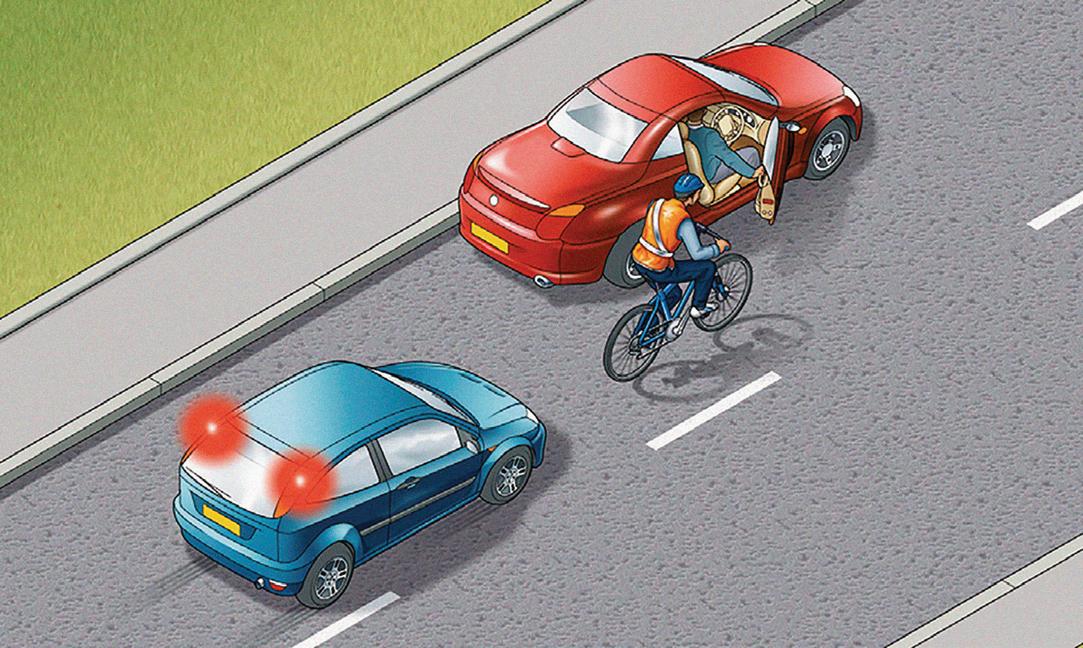

Roads minister Baroness Vere said: “These updates to the Highway Code will bring the rules into the 21st century, encouraging people to respect and consider the needs of those around them, and ensuring all road users know the rules of the road.”
The government said the Highway Code needs to keep
pace with the way in which people get about, as well as with changes to transport infrastructure. For example, the updates recognise new cycle-friendly signals and cycle junctions, so people know how to use modern carriageways. Cyclists are also encouraged to consider training in order to have the skills, knowledge and confidence to ride safely and responsibly on the road.
Active travel commissioner for England Chris Boardman said: “It shouldn’t take bravery to cross a road or ride to school with kids, but sometimes it feels that way. These changes to the Highway Code clarify our responsibility to each other and simply reinforce what good road users already do. This refresh does more than offer guidance though, it makes our towns, cities and villages nicer places to live.”
The government announced details of the incoming updates to the Highway Code to last summer. A public consultation saw 21,000 people submit their
Waiting and parking (238 to 252): Rules for waiting and parking, including rules on parking at night and decriminalised parking enforcement include:
The code recommends a new technique when leaving vehicles. It is sometimes called the ‘Dutch Reach’. Where people driving or passengers in a vehicle are able to do so, they should open the door using their hand on the opposite side to the door they are opening. For example, using their left hand to open a door on their right-hand side. This will make them turn their head to look over their shoulder behind them. They’re then less likely to cause injury to:
• people cycling or riding a motorcycle passing on the road
• people on the pavement.
For the first time, the code includes guidance about using electric vehicle charging points. When using one, people should:
• display a warning sign if you can
munications drive, backed by over £500,000 in funding, raising awareness of the changes and ensuring road users across the country understand their responsibilities. The campaign will run across radio and social media channels, with further activity to follow later in the summer.
RAC head of roads policy Nicholas Lyes said: “These major changes to the Highway Code should make the roads safer for the most vulnerable road users, in particular, those walking and cycling, so are to be welcomed.
views, with the majority supporting every single one of the changes coming into force.
The Department for Transport (DfT) engaged with key stakeholders while developing the changes, and a Highway Code Communications Working Group has been established, with industry working alongside government to raise awareness.

The updates are advisory, so non-compliance will not result in a fine. However, the DfT also recently announced plans to change the laws around using handheld mobile phones while driving. They will be made stricter later this year, making virtually any use of them behind the wheel illegal, with those caught breaking the law potentially facing six penalty points and a £200 fine.
The changes have been made to the digital version of the Highway Code, and an updated printed version is due to be published in April 2022.
The government’s THINK! campaign will launch a com-
“But it’s vitally important that all road users – especially drivers – take the time to fully understand what’s new as some of the changes are a significant departure from what’s gone before. For instance, drivers turning into a road should now give way to any pedestrians waiting to cross.”
Cycling UK’s head of campaigns, Duncan Dollimore said: “The latest changes to the Highway Code are a hugely important start towards a mindset shift that will make the roads safer for everyone – not just for people who chose to cycle or walk. The changes in our driving behaviour however will only happen if government commits to communicating them with simple accurate and memorable messaging in the long term.”
The changes to the Highway Code have been welcomed by road user groups. Emily Cherry, chief executive at The Bikeability Trust, said: “We welcome these changes to the Highway Code because they encourage all road users to share their space, whilst protecting the most vulnerable.”
• park close to the chargepoint and avoid creating a trip hazard for people walking from trailing cables
• return charging cables and connectors neatly to minimise the danger to other people and avoid creating an obstacle for other road users.
Highway Code changes bring in ‘Dutch Reach’ to protect cyclistsThe Dutch Reach The Dutch Reach in the Highway Code
overnment proposals to reduce the value of parking charge notices (PCNs) will lead to a £19.5bn hit to the UK economy, the British Parking Association (BPA) has warned. The parking organisation is calling on the government to reconsider proposals to lower the level of the charges that can be levied on drivers who breach terms and conditions for parking on private land. The BPA has predicted that if the cost of parking charge notices is reduced this will diminish their deterrent value. This will mean that a quarter of currently managed private parking spaces will no longer be managed.
As part of reforms of how the private parking sector is regulated, the Department for Levelling Up, Housing and Communities (DLUHC) proposes to reduce the cap on private parking charges for the most common breaches. The current PCN level of £100 (£60 if paid within 14 days) will be reduced to £50 outside London (£25 if paid within 14 days) and £80 inside London (£40 if paid within 14 days).
Mazars, an international audit, tax, and advisory firm, conducted an impact assessment on the effect of the proposed reduction in PCNs. The auditor’s assessment concluded that the proposals would mean 23% of currently managed private parking spaces would no longer be managed. The BPA said the result will be that many destinations will become increasingly congested and inaccessible, and many commuters and shoppers will no longer be able to access transport modes, retail, or leisure destinations.
The research was conducted using Companies House data, globally recognised industry profit margin benchmarking data and anonymised BPA member data. The report concluded that the new model of reduced PCN levels will result in 700,000 parking spaces becoming unmanaged (23% of managed spaces in the UK). It further stated that 46% of BPA operators would become insolvent within 12 months and 62% by the end of year.
The BPA also cited analysis of footfall data UK towns and cities which indicates that the closure of prominent town centre car parks could lead to a dramatic decline in footfall of between 5% and 7%. The parking association argues that applying these figures to the 2019 store-only retail sales figure of £275.2bn would mean an annual decline in UK GDP of between £13.2bn and £19.5bn (GDP in the United Kingdom in 2019 was £2.25bn).
BPA chief executive Andrew Pester said: “We welcome the Parking (Code of Practice) Act and measures to introduce a single code, standards setting body and an independent appeals service. However, for this package of measures to be sustainable, there needs to be an effective deterrent to encourage compliance with parking rules and deter anti-social parking. Without effective parking management, places will become congested and inaccessible.
“Small business owners on the high street,

British Parking Association predicts cutting cost of parking charge notice could render 25% of free private car parks unviable
more people taking a risk and flouting the parking rules which are in place for everyone’s benefit. Importantly, motorists who do comply with the parking rules will find it more difficult to park, see free parking reduced and have to pay higher tariffs.”
The association points to ICM Unlimited’s Public Perceptions of Parking survey of around 3,000 adults in the UK in late 2021 which found that 75% of motorists had not received a parking ticket in the preceding three years. This result was consistent with the previous survey, run in late 2019, which found that 74% of motorists had not received a parking ticket in the preceding three years.
and retailers in general, will be affected by a decline in footfall to their stores and these impacts will be felt most acutely outside London where the deterrent will drop most, which appears to conflict with the government’s ‘Levelling Up’ agenda. And compliant motorists will lose out. Lower parking charges will significantly reduce the effectiveness of parking enforcement and see
The BPA said it will continue to work closely with key stakeholders and seek opportunities to engage with cabinet secretary Michael Gove MP and minister for levelling up Neil O’Brien MP, who has been given responsibility for implementing the Parking (Code of Practice) Act.

The BPA has more than 750 corporate members, which includes representation from local government, commercial providers, and operators of parking systems, as well as consultants and academics.
Research from Springboard and The Local Data Company for Altrincham, Hounslow and Woking shows large drops in footfall where there were significant car park closures.
• Altrincham: The Altrincham closure (156 spaces) in early October 2019 led to an average drop of 5.3% in Q4 2019 compared to Q4 2018’s footfall (October -2.6%, November -9.9% and December -3.3%). By comparison, footfall had grown by 4.9% in Q4 2018 compared to Q4 2017.
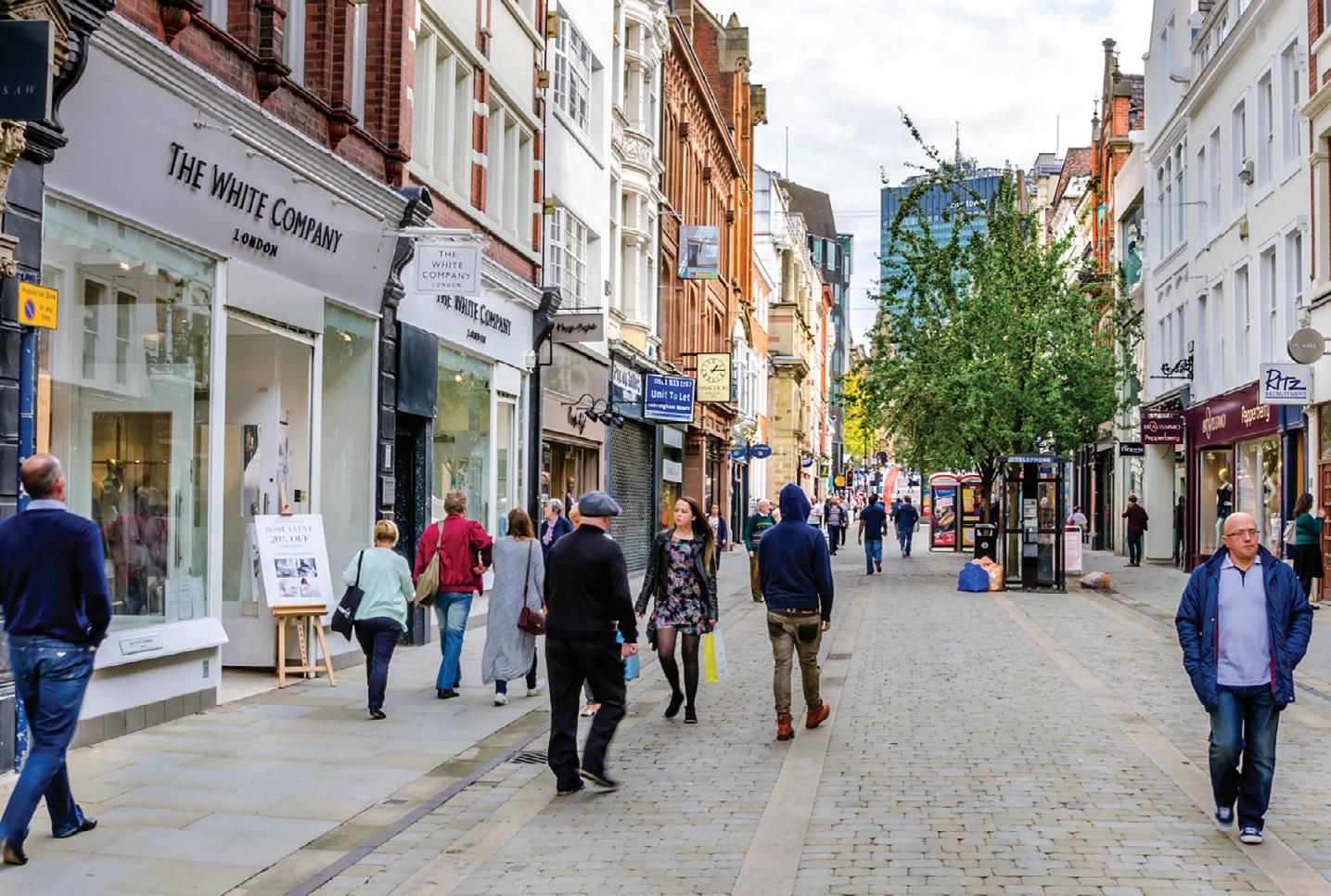
• Hounslow: The effect of the Hounslow closures (425 spaces) on 01 October 2017 was an immediate 4.8% decrease in the key Oct-Dec 2017 4th quarter, followed by drops in Q4 2018 & Q4 2019 of 3.5% and 7.1% respectively.
• Woking: The Red Shoppers car park (887 spaces) shut on 6 January 2019. The footfall count nearby dropped an average of 6.3% in 2019 vs 2018’s corresponding figures.
The government is standing by its plan to cap the cost of parking charge notices issued on private land. Under a new parking code of practice being introduced by the Department for Levelling Up, Housing and Communities, the maximum fine will be reduced from £100 to £50 for most cases.
Private car park operators will also have to display prices more clearly, run a fairer appeal system and give drivers a 10-minute grace period for lateness.
Companies that breach the new code could be banned from collecting unpaid PCNs by having their access to Driver and Vehicle Licensing Agency (DVLA) data cut off.
In a round of press articles, levelling-up minister Neil O’Brien said: “Private firms issue roughly 22,000 parking tickets every day, often adopting a system of misleading and confusing signage,

aggressive debt collection and unreasonable fees designed to extort money from motorists.
“The new code of practice will set out a clear vision with the interests of safe motorists at its heart, while cracking down on the worst offenders who put other people in danger and hinder our emergency services from carrying out their duties.”
Currently here are two parking trade associations, the British Parking Association (BPA) and the International Parking Community (IPC), each of which
has a code of practice their private sector members must abide by. Both the BPA and IPC have supported the new unified code of practice, but have expressed concerns over aspects of the reforms, such as the capping of PCNs.
In contrast, the changes have been welcomed by motoring bodies AA and RAC. Edmund King OBE, president of the AA, said: “These much needed upgrades to private parking rules will give better protection to drivers. For too long, those caught by private parking firms simply pay the charge to get rid of it.”
Nicholas Lyes, RAC head of roads policy, said: “The RAC has campaigned for years to end the sharp practices in the private parking sector, so we welcome the new national code that will usher in higher standards and will introduce a lower cap on penalty charge notices, an independent appeals system and an end to rip-off debt collection fees.”
Under the proposals, the cap
on PCNs issued in private car parks will fall by 50% in most cases, benefiting millions, the government says. But higher fines of £70 and £100 will remain for serious breaches, such as parking in Blue Badge bays.
Motorists will get a 50% discount if they pay within 14 days, as they do with council-issued fixed penalty notices.
The plans will also mean that:
• excessive debt collection fees for late tickets, which can be as high as £70, will be banned
• parking firms will have to more clearly display pricing and terms and conditions
• firms will have to give motorists a 10-minute grace period before they can issue a late fine
• they will need to introduce a 5-minute cooling-off period in which a motorist can change their mind about parking.
The government also said it planned to make it easier for drivers to challenge their ticket if there are genuine mitigating circumstances.
We are International Parking Systems (UK) Ltd. Offering the latest Pay & Display technology, an innovative back-end Data Management System (DMS) and first-class customer service.
The only parking terminal manufacturer in the market, who are a fully accredited Payment Services Provider (PSP).
We process tens of millions of card transactions per year!
If you want to introduce contactless payments on your parking terminals, the newest form of credit/debit card payment is available from IPS.

legal obligations to deliver compliance with NO2 limits in the shortest time possible.”
Plans for a Clean Air Zone (CAZ) across Greater Manchester have been put on hold, with the area’s local authorities in the region seeking a government review of policy, including into the availability of cleaner vehicles. The CAZ had been scheduled to be launched on 30 May, but this has been delayed until July.
The mayor of Greater Manchester, Andy Burnham, had requested more time to allow local authorities to review plans after evidence suggested the city was unlikely to meet legal emissions limits by the original date of 2024. The government has now agreed to a 2026 target for meeting emissions limits.
Evidence provided by the Greater Manchester Combined Authority (GMCA) suggested the impact of issues such as COVID19 on supply chains and the price and availability of secondhand vehicles will make it harder for people to upgrade to cleaner vehicles.
A key problem, said Burnham, was that the current Greater Manchester CAZ was designed
before the pandemic. “It was based on a legal direction from the government requiring action in all 10 Greater Manchester boroughs to clean up the air and compliance in as short a time as possible and by no later than by 2024,” he said.
“It is the nature of this government direction, and the tight timetable, which has shaped the CAZ proposal, together with the government’s requirement to use a charging CAZ as the default option. We have repeatedly raised concerns over a number of years about the level of funding being offered by the government to help people upgrade vehicles. These concerns inten-
sified last year when the effects of the pandemic became clear.”
The government said it had considered Burnham’s request and that the environment secretary, George Eustice had agreed to a short delay. The Department for Environment, Food and Agriculture (Defra) said the delay will allow Greater Manchester councils to provide further evidence and a revised plan by July setting out how it will deliver legal levels of NO2 [nitrogen dioxide] as soon as possible, and no later than 2026. Defra said: “In making this decision, the environment secretary has made it clear that it is his priority to fulfil the government’s
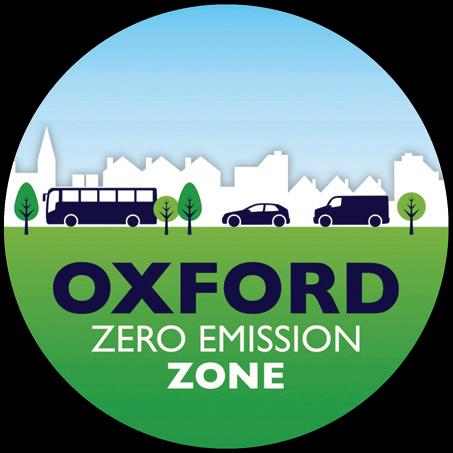
Petrol and diesel vehicles to pay daily charge on entering city centre Oxford’s zero emission zone (ZEZ) will be launched on 28 February. The Oxford ZEZ will aim to reduce toxic air pollution in the city and encourage people to make positive changes in travel behaviour.
All petrol and diesel vehicles, including hybrids, will incur a daily charge unless eligible for a discount or exemption. However, zero emission vehicles, such as electric cars, can enter the pilot area free of charge.
While many cities including London, Birmingham, Manchester, Bristol and Bath have introduced or are in the process of introducing clean air zone restrictions for vehicles, Oxford will be the first city in Britain to introduce a ZEZ.
The ZEZ pilot will allow Oxfordshire County Council and Oxford City Council to gain useful insights before introducing a larger ZEZ covering most of Oxford city centre next year, subject to further public consultation.
The charge will vary from £2 to £10 per day depending on the emission levels of the vehicle. Automatic number plate recognition (ANPR) cameras are being installed to enforce rules within the zone.
The pilot takes place in a number of streets in the city centre including: New Road, between Bonn
Square and its junction with Castle Street; Bonn Square; Queen Street; Cornmarket Street; New Inn Hall Street; Shoe Lane; Market Street, from Cornmarket junction east for 40 metres; Ship Street; and St Michael’s Street.
Cllr Duncan Enright, Oxfordshire County Council’s cabinet member for travel and development strategy, said: “This is a proud moment for our city. The first ZEZ scheme in the country is launching in Oxford. We are taking concrete actions to improve air quality in the city and to make it cleaner and safer.
“I want to thank all the residents and businesses who sent us their feedback on the pilot and worked with us to develop the scheme. Our vision is to create a zero-carbon transport network by 2040 and the ZEZ pilot is an important step towards achieving that vision. We will learn from the pilot and in the coming months we will consult with local communities as we develop plans to expand the ZEZ across the city centre. We hope that
The mayor’s office and the 10 other local councils in the Greater Manchester Combined Authority (GMCA) will now look again at the scheme and present the government with another plan later in the year.
The region was due to receive nearly £100m of government funding for vans, taxis and private hire vehicles at the end of January, but councillors are asking for these funds to be paused until government undertakes a review of the supply chain issues.
Phase one of the CAZ scheme will apply to buses, coaches, HGVs and taxi and private hire vehicles that are not registered in Greater Manchester.
Coach operators who need more time to upgrade are being urged to apply for an exemption to 1 June 2023.
Greater Manchester’s CAZ will require lorries, buses and coaches that breach NO2 emission standards to pay £60 a day, while vans, taxis and minibuses will be charged between £7.50 and £10 a day. About 285,000 private cars licensed in the region that already breach air pollution limits are exempt from the plans.
residents, businesses and visitors will join us in our journey towards a carbon neutral future.”
Cllr Tom Hayes, Oxford City Council’s deputy leader and cabinet member for green transport and Zero Carbon Oxford, said: “The launch of Britain’s first zero emission zone on 28 February would not have happened without many people’s enthusiasm, expertise, and time. Having worked personally with those people over the last four years of developing the ZEZ, I want to thank them because the ZEZ we’re launching reflects what they have said.
“The city council has chosen to set the toughest air quality standards of any local authority in the country. There is no safe level of air pollution. As the chair of the Zero Carbon Oxford Partnership we set up, the city council has helped to establish a dataled, science-based target of creating a net zero city by 2040.”
ZEZ payments can be made via county council’s website. ZEZ charges for driving a polluting vehicle can be paid up to six days in advance, on the day the vehicle is driven in the zone, and up to six days after the vehicle has been driven inside the zone.
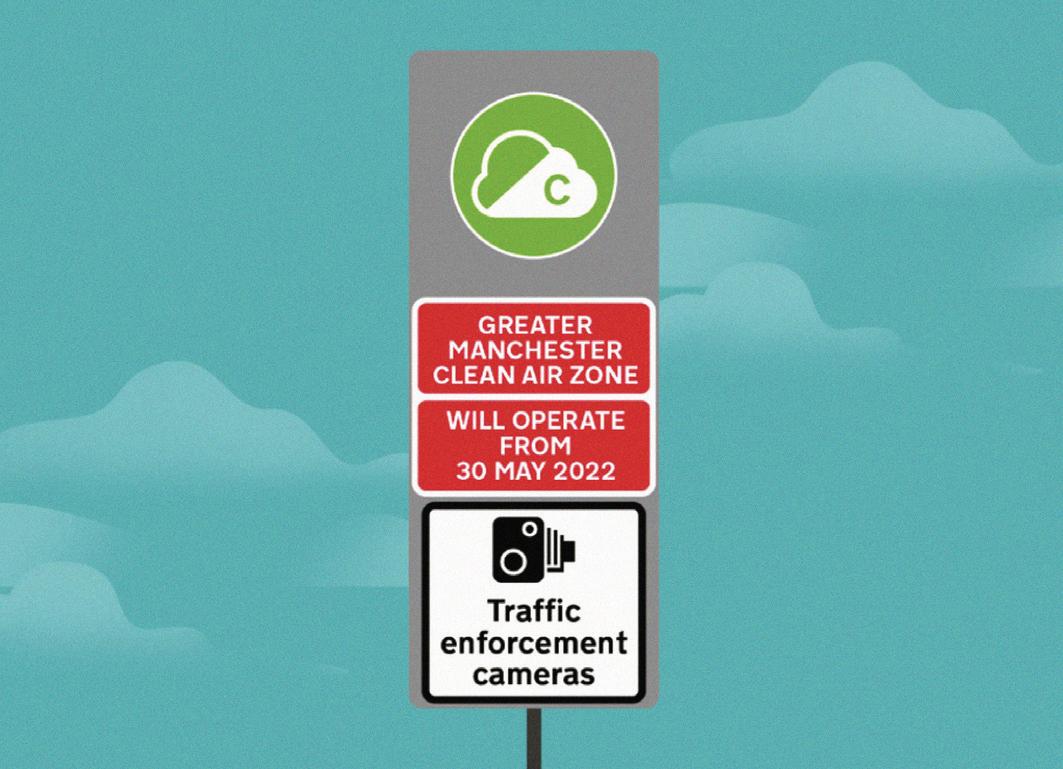
ZEZ charges will apply from 7am to 7pm, seven days a week, all year round. The daily charge covers the entire day, so a vehicle can enter and be used within the area on multiple occasions each day.
More information on the ZEZ and the charges, discounts and exemptions available can be found at: oxfordshire.gov.uk/zeroemissionzone
Government agrees to pause in Clean Air Zone implementation
Response Master gives you unrivalled:
Quality Letter quality is tracked, scored and consistently 94.5%. Consistency Your policies (800) are applied automatically. And every letter is in plain English. Productivity Super-quick. No templates. Less editing.
Working with 60 UK councils
Contact us for a demo: info@barbourlogic.co.uk
West Sussex County Council has admitted it acted illegally in removing a cycle lane in Shoreham after facing a judicial review brought by charity Cycling UK.
The 1.7-mile cycle lane on Upper Shoreham Road was installed in September 2020 as part of a wider programme of schemes funded by the DfT’s Emergency Active Travel Fund.

The programme caused controversy and in October 2020 the council approved the removal of schemes in Shoreham, Horsham, East Grinstead, Crawley, Worthing and Chichester. The Upper Shoreham cycleway was removed in January 2021.
Cycling UK initially saw its call for a judicial review of the removal of the Shoreham scheme refused by the High Court in May 2021 but this was overturned in September by the Court of Appeal.
Just before the judicial review
was due to take place on 25 January, the council declared it had acted illegally and agreed to pay £25,000 to the cycling charity’s legal fees.
Duncan Dollimore, Cycling UK’s head of campaigns, said: “In Shoreham, Cycling UK has drawn a line in the sand, showing there are repercussions for councils which ignore government guidance. Hopefully, West Sussex County Council’s acceptance they acted illegally will put a stop to short sighted decisions like this happening across other parts of the UK.”
Cycling UK hopes the new
funding and inspectorate body Active Travel England will end the need for such legal challenges. Cycling UK’s legal challenge was funded through its Cyclists’ Defence Fund, which was set up to help fight landmark legal battles.
A West Sussex County Council spokesman said: “We have settled the court case so as to avoid further cost to the public purse in relation to a decision taken some time ago and which has no implications for other proposals or schemes.”


A clearer account of government guidance and its effect
should have been included in a council report before the decision was taken to remove the cycle lane, said the spokesman.
“This may or may not have led to a different a decision about the temporary cycleway in Shoreham. Cycling UK has expended a great deal of money on this process but there is no prospect of the temporary Upper Shoreham Road cycleway scheme – which was introduced as an emergency, temporary measure during the pandemic –being restored and the guidance in question no longer applies.
“The declaration, therefore, has no significance other than to resolve the litigation Cycling UK chose to undertake. We decided to minimise costs by making the declaration rather than have the matter go to a further hearing where the best outcome Cycling UK could reasonably have achieved would have been the declaration now agreed.
“As part of the settlement, the county council offered to make a contribution of £25,000 towards the legal costs incurred by Cycling UK.”
Pembrokeshire County Council has decided to trial automatic number plate recognition (ANPR) to enforce parking and the closure of a bridge during high winds.
be provided by Derbyshire at a cost of £23,000.
Poor parking is preventing fire engines from being able to attend life-threatening emergencies in Northamptonshire.
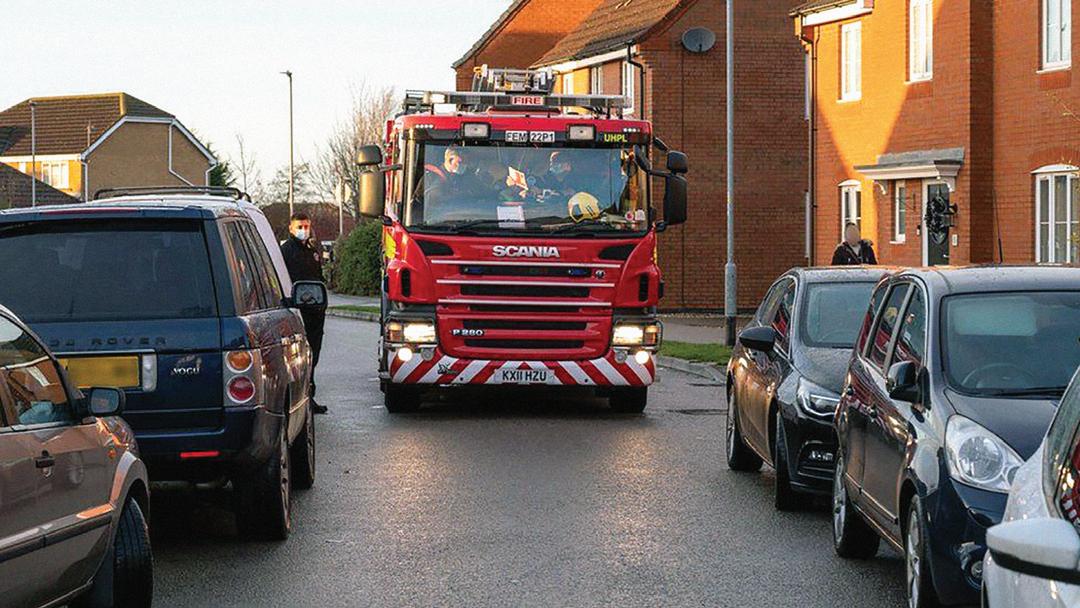
Northamptonshire Fire and Rescue Service reports that its appliances struggle to pass along roads where cars have been badly parked
In Wellingborough, Rothwell and Irthlingborough appliances are struggling to pass through streets where vehicles have been double parked, and parked down both sides of a narrow street or on double yellow lines.
On one occasion cars parked
outside a school blocked the only access point for emergency vehicles. In another case a car even parked across the entrance to a fire station. There have also been reports of vehicles parked either over or too close to fire hydrants.
Watch manager Rob Berwick said: “Parking inconsiderately not only causes unnecessary obstructions and frustrations to other motorists, but it can also make it difficult for all emergency services to access certain areas when responding to 999 calls. It could mean the difference between life and death.”
Derbyshire County Council, 250 miles away, will provide the equipment and process ANPR reports, but Pembrokeshire officers will review the evidence before deciding whether penalty charge notices (PCNs) should be sent out.
Pembrokeshire already employs civil enforcement officers for on-street and offstreet parking sites across the county, but there are concerns that this activity “fails to meet expectations” in key locations, such as at schools, bus stops, taxi ranks, pedestrian crossings and places with loading restrictions.
A working group previously suggested the use of an ANPR camera car. This was not progressed but the cabinet has now agreed to an 18-month trial of four fixed cameras, to
Derbyshire will also provide back office support, at a cost of £22,000. Installing infrastructure and software will cost £20,000.
ANPR will also be used for enforcement at the elevated Cleddau Bridge, north of Pembroke Dock. During strong winds, high-sided vehicles –which include vans and caravans – are prohibited from using the bridge.
Darren Thomas, Pembrokeshire’s head of infrastructure, told cabinet members that Derbyshire County Council would process the evidence and send it to Pembrokeshire during the pilot period.
He said: “The evidence would then be reviewed by a Pembrokeshire County Council civil enforcement officer prior to issuing the penalty charge notice. Local knowledge was deemed to be an important factor when reviewing the evidence.”
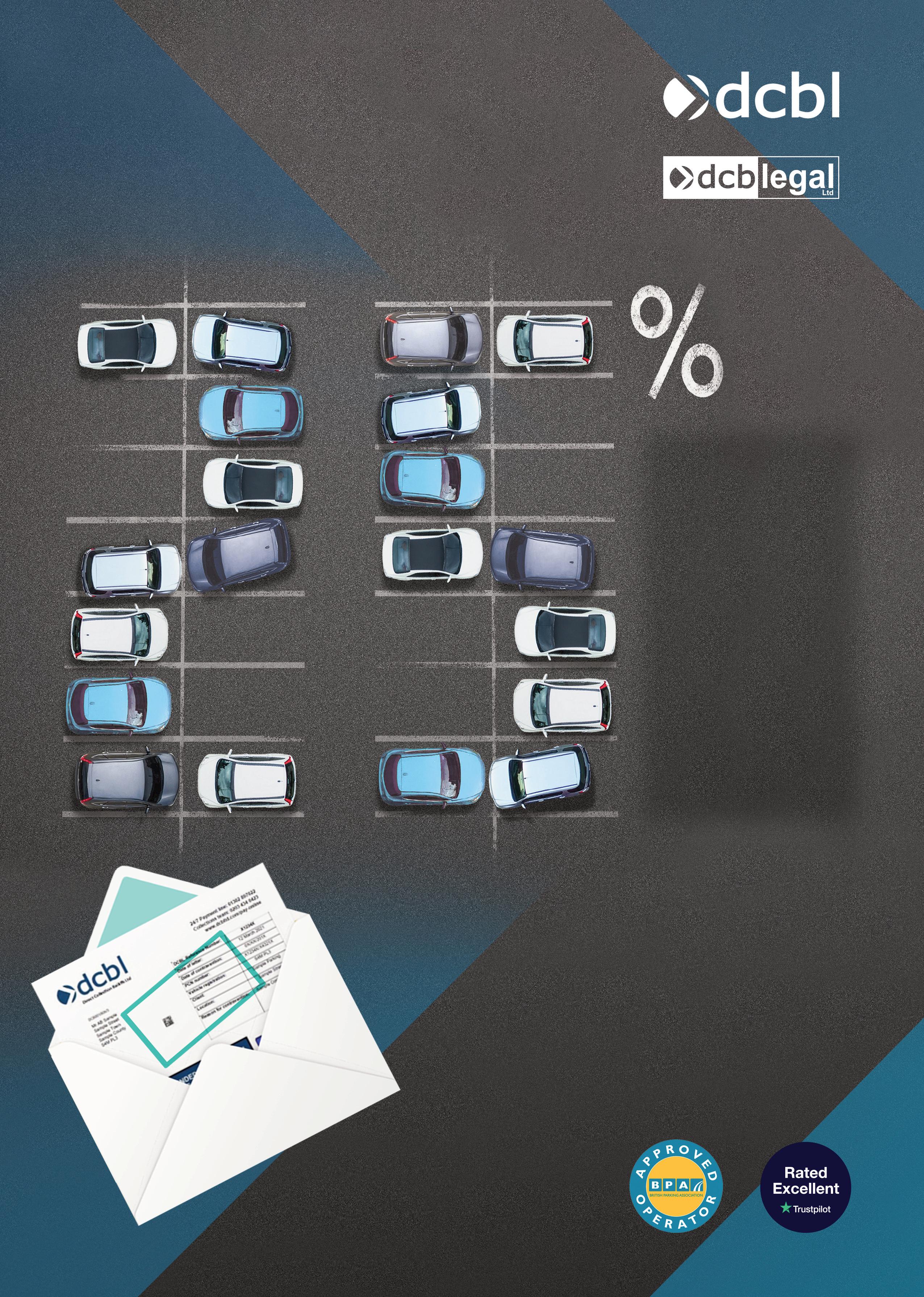














Travel
PCN is issued by post.
The Dartford Crossing saw its revenues fall by a quarter (25.5%) during the pandemic as travel restrictions reduced traffic volumes between Kent and Essex, National Highways has revealed.
The tolled crossing comprises two tunnels and the Queen Elizabeth II Bridge.
Latest accounts for the year ended 31 March 2021, show income generated from the river Crossing, which uses a free-flow charging system known as the Dart Charge, decreased by £47.6m to £161.4m.
The government-owned company said this was in large part due to the lockdown restrictions.
The drop in traffic resulted in a 28% fall in penalty charge notices (PCNs) issued to drivers who failed to make a payment within the required timescale. However, despite this fall in activity the operators of the Dart Charge continued to rake in more than a third of its income through fines.
Total expenditure for the year ended 31 March 2021 amounted to £92.8m (2019-20: £102.2m). The decrease in expenditure is led by a reduction in managing agent contractor costs.
Cash receipts collected by contractor Emovis Operations for paid crossings are passed over gross to the Department for Transport (DfT). Total revenue recognised for the year ended 31 March 2021 amounted to
£161.4m (2019-20: £209.0m).
The utilisation of the income for transport purposes is fulfilled through the parliamentary supply procedures. This ensures that the whole of the income is received and appropriated in aid and set against the DfT’s total transport expenditure. The net proceeds from the charging scheme are used to offset the generality of transport expenditure and not hypothecated to programmes or projects.
The net proceeds for the year ended 31 March 2021 were £68.6m (2019-20: £106.8m), the decrease of £38.2m is due to the reduction in income of £47.6m offset by a decrease in expenditure of £9.4m. The £47.6m decrease on the previous year includes:
• a £24.3m reduction in the value of road user crossings caused by a reduced volume of traffic during the COVID-19 pandemic
• a £14.2m fall in enforcement income due to both the reduction
in traffic volume and COVID19 restrictions on enforcement activity
• a further £9.1m reduction in the value of aged-deferred income now recognised as income in line with the revenue recognition policy.
The Dart Charge removes the need for drivers to stop and pay the road user charge (RUC) within a plaza environment controlled by barriers. This scheme formed a key deliverable within the department’s 2012-15 business plan, and the agency led on its delivery and it was introduced from November 2014.
Dart Charge requires drivers to pay for their crossing during chargeable hours, either in advance or by midnight the day after crossing. Road users have access to a variety of methods to pay the charge. These methods include payments online, by phone, retail outlets, or by registered customer accounts. If a payment is not made, then a
CO2 emissions from vehicles passing through the Tyne Tunnel were reduced by 90% after a move to payment at the end of last year
An open-road tolling structure was launched on 8 November 2021 by TT2, the company who run the North and South Tyne crossings on behalf of Transport North East (TNE),

The reduction came as vehicles repeatedly stopping, starting and accelerating – like they used to at the payment plazas – creates far more emissions than cars, trucks and vans moving continuously, TT2 explained.
TT2 said it expects reduce carbon emissions by 50,000 tonnes in the first year of open-road-tolling.
Around 1.4 million journeys are made through the tunnel every month. Drivers can decide to either pre-pay or pay later. Those wishing to pay later are asked to pay by midnight the day after their journey, via TT2’s official website, app, telephone
number or by cash or card at a suitable PayPoint outlet.
TT2 chief executive Philip Smith said: “The investment in a more modern operation has provided quicker, smoother journeys for customers and now it has been shown to have significant environmental benefits to boot. The reduction in
Penalty and recovery processes are employed to enforce the charging scheme and collection of charges. These ‘charging and enforcement management’ services are delivered and administered through a contact centre and back office operation.
To build road user understanding and acceptance of the Dart Charge and to encourage compliance, first time users of the crossing are offered the opportunity to avoid the penalty charge if they pay the RUC within 14 days of receiving a PCN.
Traffic volumes decreased by 25.5% in 2020-21 compared with 2019-20 as COVID-19 and the associated restrictions imposed by government had a severe impact on traffic volumes. It is estimated that up to 14 million crossings were lost in 2020-21 when compared with a typical year. Volumes decreased during charging hours by 24.6% and by 31.5% outside of charging hours. The total volume of chargeable crossings in year was 36.9m (2019-20 48.9m).
At 94.9%, road user compliance remained static in 202021 (2019-20: 94.9%). Compliance is a measure of road users who have used the crossing and paid their RUC in-line with the scheme requirements, by midnight the day after crossing. Crossings are captured and validated by the roadside technology, and then reconciled to payments. Crossings are then grouped by type (e.g. ‘paid by account’), following which a compliance value is derived.
emissions will inevitably have a positive effect on air quality for those who live and work near the tunnels and will continue to reduce further when the roadworks to remove the old plazas are complete.”

The North East Combined Authorities (NECA) formally declared a climate emergency in 2019. NECA plans to become completely carbon neutral by 2030.
TT2 was certified as carbon neutral by the Carbon Trust in 2020. This was achieved through a range of measures including installing LED lighting in the tunnels and ensuring all of its electricity is generated from certifiable renewable sources –with the company now focussing on reducing indirect emissions.
Cllr Martin Gannon, chair of NECA, said: “This is a positive step towards the de-carbonisation of the transport network and a vision of moving to a green, healthy, dynamic and thriving North East as outlined in the North East Transport Plan.”

restrictions saw traffic fall by a quarter, says National HighwaysCllr Martin Gannon and TT2’s Philip Smith Free-flow arrangements at the Dartford Crossing
Top 5 local authorities with highest number of prosecutions: England
Local authority No. of prosecutions
Lambeth 119 Birmingham
Hammersmith and Fulham 92 Bromley 70 Buckinghamshire
The fall in prosecutions and general numbers of Blue Badges has been partially attributed to repercussions of the COVID19 pandemic. The DfT stated: “The drop in prosecuted badges may relate to the effects of the coronavirus (COVID-19) pandemic on citizen behaviour, local authority enforcement practices, and availability of resources.”
Prosecutions for misuse of the Blue Badge scheme were supported by specific or general policies in 74% of local authorities (110 authorities) in England. Of those without a policy, 50% are planning on implementing one in the future.
DfT figures reveal less than 700 prosecutions undertaken
The number of prosecutions for the misuse of Blue Badges in England has fallen by 49% since March 2020, according to new figures released by the Department for Transport (DfT). Only 698 prosecutions
Disabled Motoring UK continues to be disappointed in the attitude of most local authorities toward misuse of the Blue Badge Scheme.
The percentage of local authorities that do have a ‘yes’ policy to enforcing the Blue Badge scheme through prosecution has risen this year from 69% to 74% of local authorities. On the surface this statistic seems positive, but of the local authorities that have a ‘yes’ policy only 44% of them actually pursued any prosecutions on offenders. This is alarming and we firmly believe that there is no point having this policy if a local authority is not willing to act in accordance with it.
Of the 698 prosecution that did take place in 2020/21, 454 (65%) of them took place in London. Drilling down further 119 were in one particular borough, Lambeth. That equates to 17% of all prosecutions taking place in one borough of London. This means that if you live outside London you are very unlikely to see any enforcement of the Blue Badge scheme. We would like to congratulate those few
took place between 1 April 2020 and 31 March 2021, compared with the previous year’s figure of 1,429 prosecutions.
The annual Blue Badge survey, completed by local authorities in England, collates data on prosecuting misuse of the Blue Badge scheme and the number of prosecutions that occurred between 1 April 2020 and 31 March 2021.
Of the authorities which had a policy for prosecuting, 44% prosecuted individuals for misuse of Blue Badges. The remaining 56% had no prosecutions despite having a policy. There were 454 prosecutions in London (65% of the total number of prosecutions made in England). Similar to last year, the majority of prosecutions (97%) in England were targeted at a non-badge holder using another person’s badge.
Across England, the largest number of prosecutions were made by Lambeth (119).
local authorities that are prosecuting misuse of Blue Badges and give them further thanks in doing so during the turbulent times of the COVID-19 pandemic.
We appreciate that the COVID-19 pandemic has caused problems with prosecuting misuse of the Blue Badge scheme. However the already low prosecution figures have fallen of a cliff edge in this most recent set of statistics released by DfT. We hope that next year the numbers will have risen again and that local authorities will make a renewed commitment to policing the scheme so it remains fit for purpose.
We are pleased to see that more local authorities are adopting a policy to enforce the scheme through prosecuting abusers, but if they are going to adopt such policies they need to be acted upon. The charity is tired of these ‘on-paper only’ policies that are just lip service in supporting their disabled residents and visitors.
Heidi Turner is communications and campaigns director at DMUK, the national charity which supports disabled drivers, passengers and Blue Badge holders
The survey also revealed a fall in the number of Blue Badges being issued. In the year ending March 2021, some 2.35 million Blue Badges were held at 31 March 2021, which was a decrease of 3.8% since March 2020. Some 824,000 Blue Badges were issued, a decrease of 14.7% since March 2020.
In England, 4,396 badges in the year ending March 2021 were reported to be lost or stolen. Of these, 76% were reported to be lost, and 24% were stolen.
Blue Badges are disabled parking cards issued by local authorities to help people with mobility issues park closer to the goods and services they need to use.
In August 2019, Blue Badge scheme eligibility criteria were extended to include more people with non-visible, neurological disabilities that may affect their ability to access goods and services.
Blue Badges are issued according to need of the applicant and are not related to any specific condition. Anyone may be awarded a Blue Badge if they meet the scheme’s eligibility criteria. Badges can also be issued to organisations who transport people with disabilities. Upon issue, a Blue Badge is valid for a period of up to three years.

‘On-paper policies are not enough’
cover themes such as promoting awareness and compliance via publicity and traffic signs.
Regulations giving councils in England the power to enforce moving traffic regulations under Part 6 of the Traffic Management Act 2004 will come into force on 1 June, the government has announced.
Local authorities seeking to undertake civil enforcement of moving traffic contraventions will need to apply to the secretary of state for an order designating the council as the enforcement authority in their area.
Councils in London already have the powers to enforce moving traffic contraventions, including school streets.

The timetable for introduction of the measures came from transport minister Trudy Harrison in an answer to a question from Lloyd Russell-Moyle, Labour MP for Brighton Kempton.
Harrison’s response stated that the Department for Transport
(DfT) has written to councils in August 2021 with an advice note and then sent out complementary advice in September 2021 that included a list of traffic signs subject to moving traffic enforcement.
Subject to Parliamentary approval of the regulations, Harrison wrote that the DfT plans to publish statutory guidance in late March.
“Depending on initial uptake, it may be necessary to deliver Designation Orders in tranches,” wrote Harrison. “We plan to lay the first Designation Order after
the regulations come into force to enable enforcement to commence in practice.”

A pair of statutory instruments have been laid before Parliament immediately covering:
• evidence, enforcement of penalties, income and expenditure, and adjudication
• level of penalties
• approved devices
• representations and appeals.
The instruments are scheduled to come into effect on 31 May 2021.
The statutory guidance will
Local authorities wanting to adopt moving traffic enforcement powers will need to consult with the appropriate chief officer of police and engage with the public for at least six weeks, focussing on the detail of planned restriction types and locations.
The engagement exercises are not full public consultations, so local authorities do not have to ask people to agree in principle and do not have to use newspaper advertising. However, they are advised to use the full range of media available, such as local press, social media and email newsletters, up to the start of enforcement and for a reasonable period thereafter.
The officers stressed that moving traffic regulation enforcement should not be about revenue raising, warning that overuse of the powers could result in adverse publicity, bring schemes into disrepute and reduce compliance.
Local authorities need to apply to DfT for Designation Orders
University of Bath and Chipside use AI to study
The use of an artificial intelligence (AI) approach to analyse driver behaviour will be the subject of a research project run by IT company Chipside and the University Bath.

The project will be undertaken as a Knowledge Transfer Partnership (KTP) that will see the university support Chipside in setting out a strategic systems roadmap to 2025, which brings local government parking, city access, and vehicle movement in line with the ten-point plan set out by local government.
The KTP combines specially developed algorithms with the latest thinking in AI applications. This will enable Chipside to develop a suite of real-time AI decision services, designed to enable local authorities to better understand and control their regional transport networks.
Dr Özgür Şimşek, deputy head of computer science who leads the Artificial Intelligence Research Group at the University of Bath, will be the knowledge base lead for the KTP. Co-supervision of the partnership will be provided by Dr Fincham Haines, a lecturer in machine learning also from the Department of Computer Science and member of CAMERA (Centre for
Daniel Hanshaw has joined consultancy Smart Transport as commercial director on a part-time basis. Hanshaw is also transport policy lead at Lewisham Council. He has previously been highways programme manager at Sutton Council, an account director at Marstons Holdings

the Analysis of Motion, Entertainment Research and Applications) which is funded by the Engineering and Physical Sciences Research Council (EPSRC) and the University of Bath.
Dr Şimşek said: “We look forward to collaborating with Chipside and applying our AI capabilities to support their strategic systems roadmap. They have a progressive development team that is keen to learn and include this knowledge into their processes.


“This AI informed real-time behaviour data can be offered to both town and city managers and to the public simultaneously,
to change immediate behaviour and guide commuters to different areas of the city. Dynamic pricing can also be introduced to incentivise time-flexible trips, lowering pricing after peak times to shift the time of travel and alleviate congestion and high pollution.”
David Wright, co-founder of Chipside and industrial supervisor for the KTP, said: “The new knowledge gained from the partnership will be transformational for our company. It will form an intrinsic part of our software development strategy for the future, allowing us to expand our capabilities and more importantly reduce pollution and manage mobility supply and demand
in real-time.”
Dr Izaro Lopez Garcia, business partnerships manager in Research and Innovation Services (RIS) at the University of Bath, facilitated the new partnership. Dr Garcia said: “This project will be a UK first for local government sharing parking and movement data across borders in real-time. Chipside systems already contain data across those borders and AI can take it a step further in achieving UK government net zero objectives.”
Funded by Innovate UK, KTPs help businesses to improve their competitiveness and productivity through the better use of knowledge, technology and skills.
 Alex Roberts has joined JustPark as its new head of electric vehicle key accounts. He will be leading the growth of FleetCharge, JustPark’s charging solution for business EV drivers without access to offstreet parking at home.
Alex Roberts has joined JustPark as its new head of electric vehicle key accounts. He will be leading the growth of FleetCharge, JustPark’s charging solution for business EV drivers without access to offstreet parking at home.
new legislation which is being made available for councils outside of London in 2022.”
Alpha Parking has launched five new training workshops for new entrants to the parking sector. The one-day online events are designed to give delegates a well-rounded knowledge within subject areas such as civil parking enforcement, notice processing and moving traffic regulations.




The new workshops are:
• People New to the Parking Industry –Apprentices
• People New to the Parking Industry –Team leaders and above

• Evidence and its importance for civil enforcement officers
• Evidence and its importance for notice processing officers
• Moving Traffic (available from March 2022).
“These new training options are being offered as part of our suite developed by our inhouse specialist trainer,” said Penny Winder, director of Alpha Parking. “The workshops are aimed at people new to the industry and those seeking to extend their knowledge in specialist areas.
“The workshops should ideally be booked
before booking the core City & Guilds courses, as it will give the delegates knowledge on the industry as a whole. However, our specialist courses do allow bespoke options should any specific requirements need to be covered.”
The training currently in most demand is relates to moving traffic regulations, reports Winder. “Moving Traffic supports parking teams and gives them knowledge on the
The workshops are run online. “All our virtual training allows up to six people to attend, we feel this rounded number is great for a good connection, discussions and online break out room exercises,” explained Winder.
The pricing for standard one-day workshops is based on a per delegate rate. Penny Winder said: “This encourages there to be a mixture of people being able to attend.”
All five workshops will be delivered by inhouse trainers with specialist knowledge the subject. Alpha Parking trainer Tara Gabriel said: “I look forward to providing this training to councils and private companies, the courses are set up specifically for the subject and will be very useful for those new to the industry or as a refresher to those who would require this.”
Alpha Parking will be developing new courses in response to changes in legislation and operational needs of parking operators. Penny Winder said: “As we look towards the future, production of training options like this provides the industry with more options to gain specific knowledge. Alpha Parking are continuously broadening the suite of parking courses available to all local authorities and private companies.”
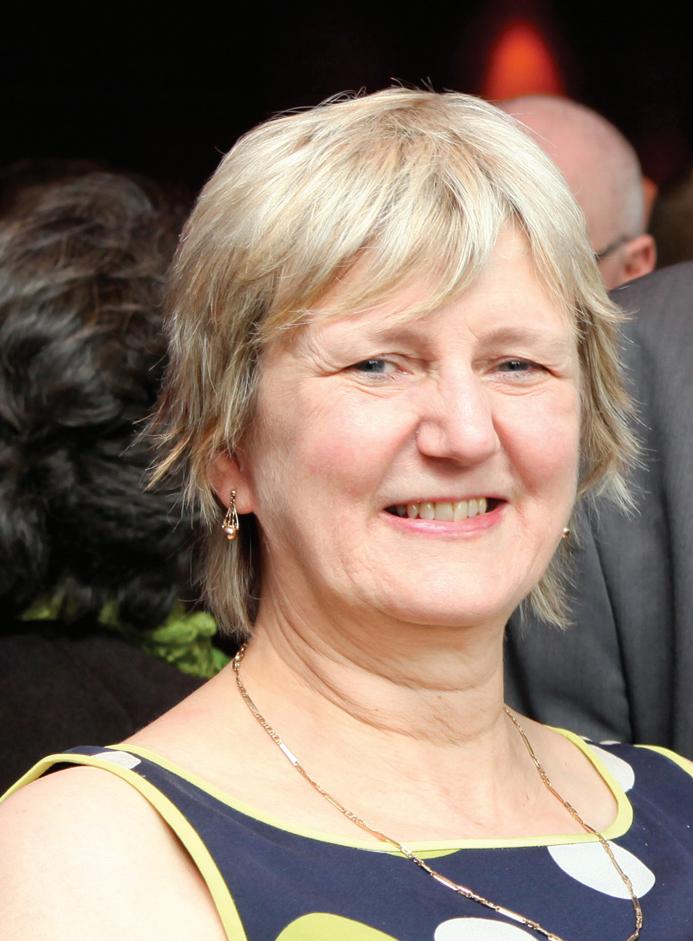
For details of the workshops visit: www.aparking.co.uk
Alpha Parking has launched five new training workshops. These courses are available for bookings now at a discounted rate over the following dates below:
People New to the Parking Industry (Apprentices) - 21st March 2022 New to the - 21st March 2022
People New to the Parking Industry (Team leaders and above) - 22nd March 2022 New to the leaders and - 22nd 2022
Evidence and its importance for civil enforcement officers - 23rd March 2022 Evidence and its for civil enforcement officers - 23rd 2022
Evidence and its importance for notice processing officers -24th March 2022 Evidence and its for notice officers -24th
Moving Traffic - 28th March 2022 and 29th March 2022 Traffic - 28th March 2022 and 29th March 2022
www.aparking.co.uk
Sessions introduce new joiners to key themes such as civil enforcement and moving trafficPenny Winder
Yorkshire, home to SWARCO Traffic’s head office.
Traffic technology specialist SWARCO Traffic has revealed the latest recipients of its SWARCO Traffic Business Fund.
Launched in 2020, the initiative supports local businesses and charitable organisations experiencing financial hardship caused by the COVID-19 pandemic. SWARCO has selected two charities, Food for Thought Darlington and Shelter, who each receive a donation of £2,500.
Food for Thought Darlington, under 10 miles away from SWARCO’s head office in Melsonby, is a registered Community Interest Company working to tackle the issues of food waste and food poverty in the Darlington area, working with supermarkets and other local business to re-distribute surplus food and supplies to those in need.

As well as providing local people and families with food and supermarket vouchers, they have also provided community bicycles for those who have no other
means of transport.
Shelter is one of the UK’s biggest charities fighting the issue of homelessness and the devastating impact of the ongoing housing emergency. Every year, Shelter provides support, information and advice to millions of people whose lives have been blighted by the loss of their home or those experiencing inadequate housing or the threat of eviction.
John Pickworth, managing director of SWARCO Traffic, said: “We created this fund to
Freddie Jones has joined International Parking Systems (UK), as country manager. He was most recently chief executive EMEA of the gotikket passenger transport ticket app.

Jones takes over from Richard Boultbee, who has moved to Creative Car Park, where he becomes director of business development.
Of his time at IPS, Boultbee said:
“I am proud we grew a company into a successful business in four years, with so many achievements in a very tough market.
“One of the greatest achievement was to grow by another £500,000 last year, in the face of such adversity and with all the restrictions of COVID. We had a tough year, but we survived, and we achieved a lot in a time when so many companies did not make it.”
help support local businesses and organisations, as well as charities who make a difference to society. The issues of hunger and homelessness have only been exacerbated further by the pandemic, so we hope these donations can help these two important causes to continue their amazing work.”
Additionally, SWARCO has also donated £1,000 to four sports clubs and organisations: • Team Caterpillar running club is a community running club based in Richmond, North
• Flitwick Dolphins Swimming Club, situated approximately 15 miles from SWARCO’s operations hub in Milton Keynes, offers swimmers the opportunity to participate in competitive swimming events at all levels and for all ages.
• Catterick Garrison FC Wildcats is a non-competitive football club for girls between ages five and 11, created for girls interested in trying the sport for the first time, but most importantly having fun and making friends.
• Bakewell Town under-12s futsal team currently competes in the Chesterfield Futsal League.
Each of these organisations will receive a donation of £250. “This year, we have also selected these four sports clubs based on their work for their communities,” said Pickworth. “Each of these organisations are doing a great job in encouraging local people and members to grow and to be active and healthy, for both their physical and mental wellbeing, something that has been so vitally important over the past year or so.”
PayByPhone is donating 51,770 trees on behalf of its local authority and private operator clients under its Green Christmas seasonal initiative. The scheme turns December’s phone parking transactions into trees.
This total of trees exceeded last year’s donation by over 10,000, and brings the total of trees donated to 128,923 since the initiative was launched in 2019.
The trees are planted in mangrove projects in Madagascar that supports reforestation and provides essentials such as medicines and food to villagers.
Anthony Cashel, UK marketing and operations director at PayByPhone, said: “How we treat our planet matters to us, and forms the basis of our business decisionmaking. The results of our 2021 Green Christmas initiative have surpassed our expectations.
“I would like to thank our clients of course, but the real appreciation goes out to the motorists who used our app in December because they made it possible to donate such an impressive number of trees this year
to a very worthy cause. Green Christmas and our multi-awardwinning Meters for Trees initiative are just two ways we are helping to leave a sustainable legacy for future generations.”
Green Christmas is run in partnership with Eden Reforestation Projects, an NGO that preserves the world’s rapidly disappearing forests. The not-for-profit works directly with communities in developing countries suffering from extreme poverty resulting from deforestation.
PayByPhone’s multi-awardwinning carbon footprint reduction initiative, Meters for Trees, was launched in spring 2019. It supports reforestation in the Amazon Rainforest through the Portel-Pará REDD project, which is a Verified Carbon Standard (VCS) audited project. For the councils and private operators who have signed up to Meters for Trees, PayByPhone donates double the number of trees under its Green Christmas initiative.
PayByPhone is a wholly-owned subsidiary of Volkswagen Financial Services.


Marston Holdings has acquired Vortex IoT, a supplier of environmental sensors, networks and data solutions that support improved air quality and decarbonisation initiatives.
Marston works with central and local government, utilities and private sector clients through the delivery of technologyenabled solutions from design through to implementation, management and recovery. Its clients include local authorities seeking to build environmental schemes that reduce congestion and pollution.
The acquisition of Vortex strengthens Marston’s offering by delivering complementary air quality and acoustic monitoring solutions that maximise awareness, identify pollution hotspots and improve public health.
“Air quality monitors and associated data and analytics are required to assess the success of
policy in meeting clean air targets,” said Adrian Sutton, chief executive of Vortex IoT. “Joining Marston Holdings accelerates Vortex IoT’s ability to deliver social value and environmental change for clients.”
Vortex’s products bolster Marston’s transportation technology division, ensuring Marston is best placed to meet the evolving needs of its client base. “Marston Holdings has been on a journey of enhancing technological capability,” said

Steve Callaghan, chair of Marston Holdings. “Vortex IoT’s innovative solutions now form part of our end-to-end offering delivering cleaner, greener streets.”
The Vortex deal follows Marston’s acquisitions of Videalert, a supplier of intelligent traffic management solutions; ParkTrade, a Swedish-based European tolling payments and collections business; and LogicValley, an Indian-based AIfocussed developer.
Mark Hoskin, chief commercial officer at Marston Holdings, said: “We have a long track record of successfully working in partnership with the public sector, and this acquisition reflects client feedback seeking innovative, technology-enabled solutions.
“COP26 demonstrated public support for driving the transition to a zero-carbon economy, and we are pleased to further enhance our ability to support our clients and their residents through cleaner, healthier and more people-friendly communities.”
The London Borough of Islington has appointed Rubena Hafizi as its new head of parking.
Hafizi has spent more than 17 years in the parking sector, most recently as a service director NSL.
The Islington role marks a return to the public sector . She has previously worked at Dover District Council as transport and parking services manager.

Hafizi was also parking manager at Medway Council for 11 years, during which time it won On-Street Parking Team of the Year at the British Parking Awards in 2010.

We currently supply and have vacancies around the UK for Permanent and Temporary positions:
• Civil Enforcement Officers
• Environmental Enforcement Officers
• Parking Back Office (Appeals/Notice Processing/Correspondence)
• Parking Change Management
• Interim Parking Managers
• Car Park Attendants/Marshalls/Stewarding
• Parking Supervisors (Both Enforcement and Back Office)
• Parking Management (Both Enforcement and Back Office)
• Heads of Parking/Directors
• Parking Technologies (Business Development and Project Managers/ Field Service Engineers/General Managers)
• Off Street Parking (Business Development, Contract Managers and Regional Managers)
• CCTV Operators – SIA and BTEC qualified
Parking and property expert Paul Gallagher has passed away after a period of ill health. Gallagher was property director at Britannia Parking Group for over 25 years before joining JLL as a consultant in its automotive division in 2015.


At JLL he drove the production of an authoritative annual survey of parking at shopping centres that was showcased in Parking Review.
Ollie Saunders of JLL writes: “Paul became known as ‘Car Park Paul’ within JLL, bringing bundles of enthusiasm and knowledge about the industry. He was one of the first people to spot the opportunity electric vehicles and technology would bring to the industry he was so passionate about.”
He is survived by his wife Claire and children Frankie, Georgina, Henry and Izzy.
Looking for staff or need employment? Please contact our experienced team on: Tel: 0203 668 5680

Email: parking@unity-recruitment.co.uk Web: www.unity-recruitment.co.uk

Yunex
Launched in the UK in October 2021, Yunex Traffic, formerly Siemens Mobility’s Intelligent Traffic Systems business, works alongside local authorities and traffic management teams to design and deploy a broad range of sophisticated traffic management and control solutions. Increasingly, these systems provide authorities with the tools to reduce congestion, improve traffic flow, enhance road safety and improve air quality in cities and urban areas, as well as to create safe spaces for children around schools and to provide the infrastructure needed to support the growth in electric vehicle ownership.
To deliver these objectives, Yunex Traffic has a broad portfolio of proven products and services which drive targeted improvements, but often these tools are even more effective when implemented as part of an integrated package of measures, working together to keep road users in our towns and cities moving safely, healthily, sustainably and efficiently.
To address the issue of air quality, an increasing number of authorities are deploying clean air and low emissions zones, with Yunex Traffic infrastructure and technology behind London’s recently expanded Ultra Low Emission Zone, as well as Clean Air Zones (CAZs) in Birmingham and Portsmouth. The company is also now developing schemes with authorities in Manchester, Sheffield and Newcastle.
Camera-based CAZ enforcement solutions discourage older, higher-polluting vehicles from entering specific, designated areas and are proven to make a marked and almost immediate difference.

For example, research by the Mayor of London’s Office showed that after the first month of the expanded Ultra Low Emission Zone’s operation, on an average weekday, there were 47,000 fewer noncompliant vehicles detected in the expanded zone compared to the two weeks before the scheme was introduced.
Early results from Birmingham are similarly positive, with data showing that since enforcement of the CAZ scheme started, there has been a 40% reduction in the number of non-compliant vehicles entering the zone.
Across the UK over 4,000 Yunex Traffic Automatic Number Plate Recognition (ANPR) cameras are in operation on the UK road network, with the majority of London boroughs having already adopted the company’s ANPR camera technology.

Of course, air quality improvements are helped by the rapidly increasing number of electric vehicles (EVs). It is important that the industry, local authorities and government work together to support this growth in EV ownership with the roll out of reliable, rapid chargers. More schemes such as the innovative EV charging hubs that have recently been opened in Woolwich and Somerset, and which feature Yunex Traffic charging technology, are needed to help deliver an efficient transport network and a cleaner, healthier, more sustainable and more attractive environment. As this national network of charging infrastructure continues to expand, it is vital that it is well serviced and maintained to provide the high levels of availability and reliability that are needed to build confidence in, and address the anxieties of, EV ownership.
But while these large, dedicated hubs and city-wide Clean Air Zone schemes might grab the headlines, even relatively small interventions, such as those enforcing yellow box junctions and bus lanes, will deliver considerable benefits.
The role of a focussed, local enforcement scheme might be to reduce congestion at a particular junction, but by doing this, it also helps improve the traffic flow in its surrounding area and as a result, improves air quality and road safety.
As an example, and as part of a trial by Buckinghamshire Council to assess moving traffic violations, Yunex Traffic supplied enforcement cameras at three locations in the county, installing two ANPR enforcement cameras at locations in High Wycombe and one in Marlow.
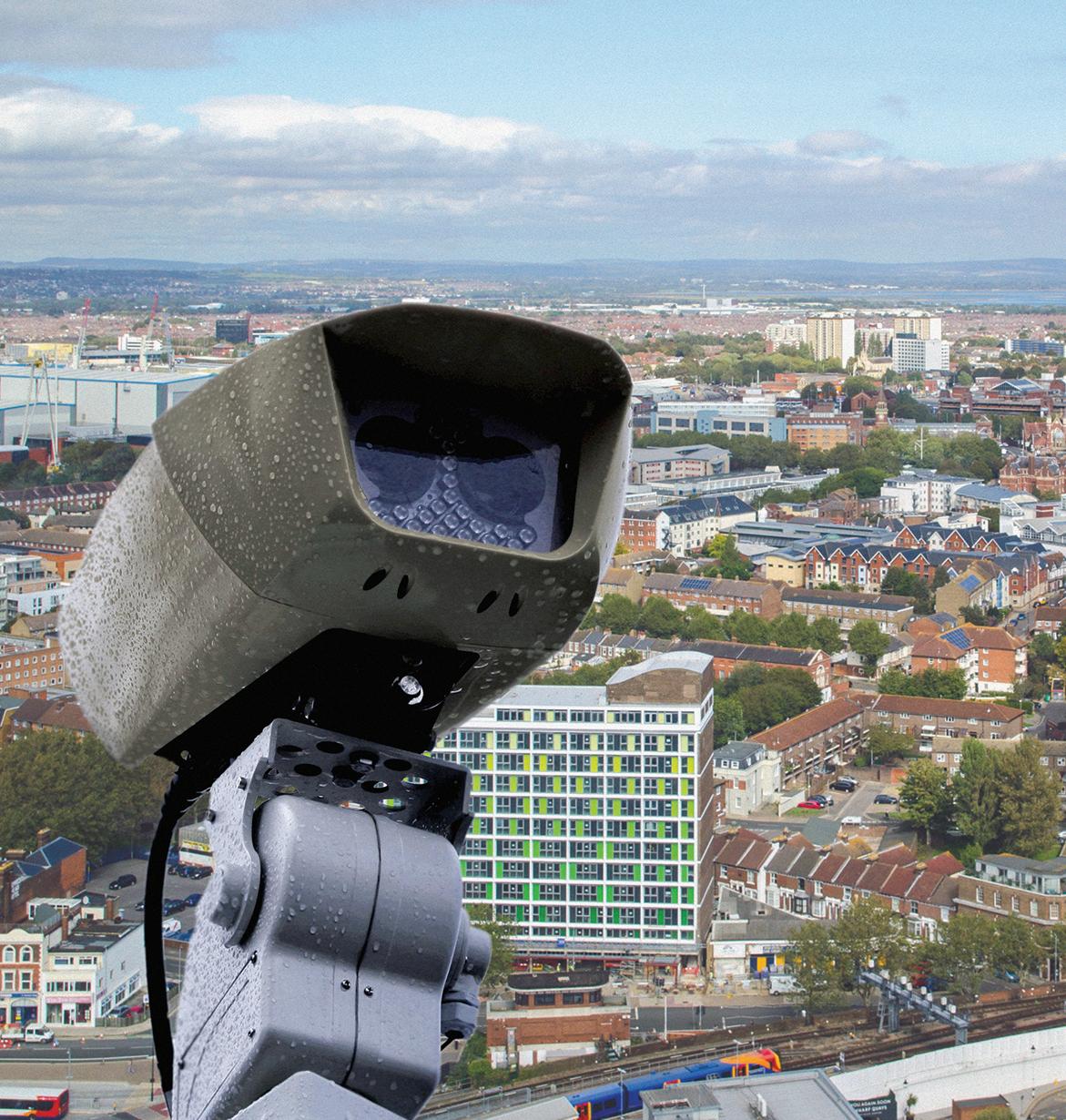
The three specific sites were selected for the trial in response to multiple complaints to the Council from residents and road users. The two sites in High Wycombe are bus gateways, which have been reported to be frequently used by car drivers, while at Marlow Bridge, vehicle drivers regularly overlook the weight restrictions which are in place to protect the structural integrity of the historic bridge.
Across all three sites, the contraventions have caused significant disruptions and raised safety concerns for all road users. The temporary cameras will give the Council a better understanding of the number of vehicles currently breaking the rules and the way motorists are using the areas, enabling it to address specific issues and introduce measures to improve safety and accessibility.
Taking place in advance of changes to the Traffic Management Act (TMA) which are expected to be implemented in spring 2022, the trial will provide important data in support of the Council’s application for potential new enforcement powers.
Currently, outside London and Cardiff, such regulations are enforced by the police, but after Part 6 of the TMA is introduced, all local authorities will be able to enforce the traffic regulations they have in place.
Councils will then be able to deploy a wider range of enforcement tools, which together with the greater power and control from Part 6 will allow them to integrate civil enforcement measures with other aspects of their broader traffic management plan, to help deliver their safety and emissions targets as part of a fully integrated and cohesive network strategy.
James Riley, Head of Enforcement Sales at Yunex Traffic, said: “Major schemes like Clean Air Zones are incredibly effective, but when they are deployed as part of a package of complementary


measures, they can be so much more powerful. With this new set of tools available to Councils, we’re looking forward to working closely with authorities to develop strategic, network-wide solutions that encompass the various capabilities and solutions that are available to them, and which are proven to make a difference.”
In London, where authorities already have the powers to enforce certain moving traffic contraventions, enforcement solutions are helping boroughs to better manage traffic flow, reduce congestion and improve air quality. For example, the changes have enabled Yunex Traffic to work with a number of authorities to introduce dedicated School Streets schemes, aimed at changing driver behaviour and improving air quality around schools.
The schemes use automatic number plate recognition technology during the morning and afternoon school runs to monitor vehicular access to restricted areas during specified hours, accurately identifying potential contraventions in real-time. The results from the schemes in London already show just how effective these enforcement programmes can be in driving behaviour change and make a major contribution to improving road safety, air quality and the health and wellbeing of our children.
In the boroughs that have taken advantage of Part 6, average speeds have improved, and the number of accidents has fallen compared to other areas where the changes have yet to be introduced.
James Riley continued: “With the Part 6 changes expected to be made nationwide in spring 2022, many authorities, like Buckinghamshire, are already considering the impact of these new powers on their transport strategies and solutions. We are now actively engaging with other authorities to identify the most appropriate solutions to meet their traffic and carbon targets, including the need to balance transport efficiency with emissions and road safety.”
Nottingham City Council is keen to share its expertise as a pathfinder in the implementation of WPL schemes. It is working formally with Leicester and also providing inspiration to other cities via articles, presentations and hosting events such as the Workplace Parking Levy & Clean Air Schemes conference, held in the city’s Council House last year.
Local authorities are currently facing the huge challenge of improving air quality and many have declared climate emergencies. The challenge is how do they raise the finance to do so? One solution is to create a workplace parking levy (WPL) scheme, which enables a local authority to raise funds that can be invested in better public transport and active travel schemes.
WPL is a local traffic management approach that involves local authorities collecting an annual fee from organisations for private non-residential parking spaces. WPL disincentivises employers who provide workplace parking by placing a modest charge on that provision with a view to them reducing the supply and encouraging more sustainable modes of transport. The fees raised by a WPL must be used to finance improved local transport services, infrastructure and public realm. Schemes are created in England under the Transport Act 2000 while the Transport (Scotland) Act 2019 enables Scottish local authorities to introduce WPL schemes.
Nottingham City Council is the first, and so far only, UK local authority to launch a WPL scheme. After initial opposition from the business community, the scheme is widely regarded as having been a success in terms of stakeholder engagement, operation and revenue raising. Recent empirical studies have proven that it has reduced congestion growth by 47%.





The Nottingham WPL scheme has won a number of awards and is cited by many leading organisations as a proven way to tackle air quality and congestion. Now a number of UK councils, including Leicester and Oxford, are giving serious consideration to introducing WPL schemes.

In 2007 a study by Atkins for the East Midlands Development Agency showed that congestion was costing Nottingham £160m a year, and that half of that cost was being borne by employers directly in terms of supply chain delays. Some 70% of peak period congestion in the city was being caused by commuters. It was forecast that by 2021 congestion would grow 15%, presenting the risk that the local economy could be choked. Besides traffic congestion, Nottingham was affected by air pollution from vehicle emissions and an aging transport infrastructure.
Cities curious about the workplace parking levy should talk to Nottingham City Council, says Nigel Hallam
WPL schemes are very flexible and can be tailored to the needs and make-up of individual local authorities Nigel HallamA Nottingham NET tram outside the city’s Council House A Nottingham WPL enforcement EV
Nottingham started thinking about what it wanted in the future. The city wanted to unlock its economic vitality, but faced severe financial constraints when it came to achieving this. Key among the ideas was an ability to offer attractive alternatives to the car, which meant developing high quality affordable public transport systems in order to: protect the city’s commerce and inward investment; and improve the city’s environment and sustainability. All this has to be delivered in the context of massively shrinking funding from central government.
The reliable local revenue stream that the workplace parking levy creates has become increasingly important in subsequent years The WPL scheme has been a fantastic success. It has enabled Nottingham to deliver tangible improvements to our public transport offer, including:
• Net Phase Two: A £570m PFI project to extend a tram line into a tram network
• Hub Project: Nottingham Railway station has been brought into the 21st century
• Link: Financial support to the Link bus network provides electric buses to serve disadvantaged neighbourhoods and employers not as well serviced by the tram network or commercial bus operators.
These projects have encouraged people to shift from cars to public transport – pre-COVID 40% of journeys to work were being undertaken – and led to a 33% fall in carbon emissions since 2005.
Independent academic evaluation has determined that the WPL has:
• had a constraining effect on congestion growth
• not damaged inward investment, on the contrary, there is evidence that the excellent public transport options are proving an attractor for employers to locate into Nottingham.
The reduction in this forecast congestion growth is saving employers £7.5m a year and the city as a whole £15m. The investment into an electrified and integrated public transport system meant that Nottingham was the first city to have its Air Quality Management Plan approved by government. Importantly the plan was approved without the need to introduce a charging Clean Air Zone (CAZ).
The charge is currently £428 per place and all revenue raised by the levy is ring-fenced by law to be spent on locally identified transport improvements. Nottingham is not “anti-car” but is procycling and active travel. A higher charge would have a stronger demand management effect, but there is a balance to be struck with the ambitions for each scheme and possible impacts.
The city council offers a comprehensive business support package, including WPL funded travel planner who, amongst other things, provides car park management advice, journey planning and support with grants for active travel and ultra-low emission vehicle (ULEV) charging infrastructure.
The business community has bought into the scheme. This means that Nottingham has achieved 100% compliance among liable employers since the first year of the scheme.
WPL schemes are very flexible and can be tailored to the needs and make-up of individual local authorities. They are also scalable, both up or down. The Nottingham scheme covers the whole of the administrative boundary, but towns and cities can tailor a WPL scheme to fit local needs.
In Nottingham we have spent a great deal of time looking at what we did well and considering where we would do things differently based on experience. This enables us to provide informed and expert advice to local authorities and public organisations interested in WPL.
Nottingham City Council offers consultancy service, led by Jason Gooding, Nottingham’s head of parking, fleet and transport services and myself. We offer advice at the outset of schemes, evaluating whether or not a proposed scheme is appropriate and viable for a specific area.
We have conducted feasibility studies to assess a local authority’s readiness to begin development of a WPL scheme. As part of that work we prepare the partner authority a bespoke route map that
Here are some lessons we have learned in Nottingham:
• Political buy in essential: A workplace parking levy is not a scheme for the feint-hearted politician as there will be challenge and opposition. WPL is still contentious, even though Nottingham is in the 10th year of its scheme.
• Vision is vital: WPL revenue is legally hypothecated to defined local transport aims, so there must be a vision of what a WPL is intended to deliver. A scheme cannot just be implemented to raise revenue.
• Early consultation is key to getting acceptance from the public and business: Importantly there is now a groundswell of public opinion that recognises the damage poor air quality does to the environment and public health, and there is a pressing need to take decisive action to reduce carbon emissions. In the commercial sector there is far greater recognition of the impact of congestion on business operations. Our experience of supporting other authorities that are either considering or have begun their WPL development journey is that business is much more receptive to the idea of a WPL as long as they can see the benefits and that brings you back to the need for a clear vision of what the WPL will deliver.
• Build a business case: Nottingham City Council prepared a comprehensive ‘Outline Business Case’ which was used during the formal 12-week public consultation which was open to everybody. This included a three-week Examination In Public which was chaired by an independent transport planner.
• Be prepared to invest in your plan: Our WPL scheme development cost Nottingham City Council over £3m and took almost 10 years to deliver. But it was worth it.
• Expert support is crucial: Seek advice from key individuals involved in WPL scheme development, implementation and operation.
identifies the key stages and activities that are necessary to complete each stage. Nottingham City Council is then able to support at each stage of a WPL route map through the provision of expert advice based on our experience.
We have developed a Desktop Parking Audit tool that uses real data from the Nottingham scheme to estimate the number of potential liable workplace parking places. The algorithm, which uses multiple regression analysis, was developed by Dr Simon Dale, who conducted the WPL evaluation and Usman Aziz, who is providing project support to the WPL consultancy team. It estimates the amount of potential liable workplace parking in the other city and enables financial modelling for the business case.
Nigel Hallam is workplace parking levy service manager at Nottingham City Council
Email: Nigel.Hallam@nottinghamcity.gov.uk

but to this day no employer has ever received one.
The one thing I am most proud of in Nottingham is our award-winning public transport network. Currently, over 40% of journeys into the city centre are made on public transport, a figure far above the national average and one that is increasing year-on-year. We believe the key reason for this is the WPL, which not only increases revenue but also alters employee travel behaviour. Increased investment in the city’s public transport, which has been made possible by the parking levy, directly benefits businesses as network improvements serve key employment sites. These transport improvements create jobs, improve infrastructure and encourage investment. In short, everybody benefits.
Since 2013 the council has also made small grants available of up to £10,000 funded by the levy to encourage the uptake of sustainable transport and to enable companies to manage their car parks more effectively.
Those who know Nottingham and its history will not be surprised that it is the first city in the country to introduce a workplace parking levy (WPL), and that tackling climate change and improving air quality are central to the council’s vision. Over many years, Nottingham City Council has taken seriously tackling climate change and improving air quality. The workplace parking levy and wider public transport policy have been central to that journey.
In Nottingham we have always been a bit rebellious and innovative. In 1642, King Charles first signalled the start of Civil War not far from Nottingham Castle. But the people of Nottingham defied their King and the town became a stronghold to Parliament. From the Luddites of 1811 to Parliamentary reform in the 1830s, Nottingham has a history of rebellion and innovation. We like to do things differently and try out ideas that are untested but which lead to good results. I like to think of the WPL as a modern example of Nottingham being at the forefront of doing things differently.
The workplace parking levy is the first of its kind in Europe. The principle of the scheme is to constrain the growth of traffic congestion by placing a modest
charge upon the use of commuter parking places. This encourages employers to reduce the amount of free workplace parking places they provide, thereby promoting the use of sustainable modes of transport. In its first eight years of operation, the scheme has raised over £83m of revenue which is then ringfenced for improvements to local public transport. It has helped pay for the extension of our tram network which, along with our municipally owned Nottingham City Transport, is helping the fight against climate change.
Nottingham has taken the risk of being first and, as such, has done the heavy lifting in establishing regulation and forming the process for establishing a scheme that works effectively. Our estimates are that improvements made as a result of the WPL will take 2.5 million cars off the road, thereby improving air quality in our city.
So, why did we decide to implement this innovative idea? Nottingham’s influence as a centre of employment is felt far beyond the administrative boundary of the city, with a potential catchment of 3 million people within an hour of travel time. Commuter travel accounts for around 70% of peak travel congestion and high levels of congestion threaten business competitiveness, posing a risk to economic efficiency.
The workplace parking levy also provides a cheaper alternative to implementing road user charging schemes. The WPL scheme relies on compliance from employers, which has been easily achieved in Nottingham as the levy continues to deliver 100% compliance from all liable employers. Civil and criminal sanctions are available,
Nottingham’s public transport usage is increasing, bucking the national trend, which has led to interest from various other authorities across the UK. In 2019 London’s deputy mayor for transport visited us to find out more about the innovative initiatives we have introduced to improve public transport use. The fact that Transport for London is looking to Nottingham for inspiration is evidence that our more original ideas are making a profound difference.
Nottingham is not complacent. The council has set the ambitious target of being carbon neutral by 2028, meaning that we are aiming to be the first UK city to achieve this. Increased usage of green public transport has reduced CO2 emissions, and this helps explain why Nottingham was not required to create a Clean Air Zone. With electric trams and biogas buses, Nottingham already has a green transport network. The WPL has helped to increase both investment in and usage of the public transport system.
Nottingham City Council has already taken the risks, done the hard work and paved the way for other local authorities to follow our lead and implement a similar system in their own area. We are uniquely placed to offer advice and guidance to other areas of the country looking to implement WPL schemes. The Transport (Scotland) Act 2019 introduced discretionary powers for local authorities to implement their own WPL schemes, showing others are replicating our innovative idea. We are ready to support other authorities in that journey.
Cllr Rosemary Healy is Nottingham City Council’s portfolio holder for highways, transport and cleansing

The Workplace Parking Levy enables Nottingham to invest in its future economic and environmental health, says Cllr Rosemary Healy
I like to think of the WPL as a modern example of Nottingham being at the forefront of doing things differentlyRosemary Healy
Organised by:
Presented by:
Supported by:

The idea of providing a concentration of mobility services at one place is emerging as a way of creating sustainable public transport systems.
When reimagined as mobility hubs, car parks are no longer just places to store vehicles. Instead they become positive places that offer co-located services such as electric vehicle (EV) charging and shared mobility services.
Mobility hubs also represent the next step in the evolution of park & ride services, which will become genuine interchanges where people can switch from private cars to buses, trains, cycles and walking.
EV hubs offer drivers access to chargepoints in car parks at destinations such as shopping centres or in service area style facilities on major roads. The parallel emergence of service hubs is seeing other car parks acting as bases for logistics services and a range of activities such as ‘dark kitchens’ and ‘dark stores’.
This one-day conference will see speakers and expert panels explore the design, implementation and operation of mobility, EV and service hubs.

Who should attend:
park operators

Worryingly, the problem of nuisance vehicles is growing as more persistent evaders seek ways to avoid complying with traffic management measures such as clean air zones, moving traffic regulations, parking permits and river crossing charge schemes. If not solved now, nuisance vehicles pose a genuine threat to the operation and credibility of any future road user charging schemes.
The good news is that it is possible to identify and tackle persistent evaders, to remove nuisance vehicles from roads and recover unpaid fees and charges. Civil enforcement agencies are working with local authorities, highways authorities and police forces at a local level while also leading a debate to ensure the issue is recognised at a national policy level.
THE EVENT
The summit is more than just a seminar, it is an opportunity for attendees to hear the latest research and share best practice. It is a forum in which they can become part of the solution to this pressing problem. The day will comprise expert presentations, Q&A panels, networking and a closing debate.
SPEAKERS INCLUDE: l John Mason, Director, CDER Group l Alan Wood, Strategic Account Director, JUST l Tim Ashman, Director, TJA Associates l Paul Cowperthwaite, General Manager, Road User Charging, Transport for London KEY
THEMES
As a member of the British Parking Association I totally support the organisation’s belief in equality, inclusion and fairness. As BPA president I have the honour of sharing these values with people working in the sector and members of the public who use the facilities we operate. Communication is key to my role as president, and getting this message across relies on understanding how the terms “equality”, “inclusion” and “fairness” can be applied to the lived reality of disabled people, many of whom depend on the facilities and services that the parking sector provides to go about their daily lives.
I am aware that I can come across as someone with a thick skin – years of military service will do that to you. Anyone who has seen me in action will know that I crack a lot of jokes, which can give the impression that criticism (however fair) would roll of me like water off a duck’s back. It is fair to say that I am not given to much in the way of introspection. But, in truth, I am incredibly conscious of how people perceive me, and of how I make people feel. I am aware that comments made without thinking or understanding that can be hurtful and harmful, so I asked my BPA colleagues for help in finding a training course that would help me to better understand issues relating to equality. This is how I was put in touch with Enhance the UK, a charity run by disabled people that aims to change the way disability is viewed for the better.
I spent a full day with the trainer, Claire, albeit by Teams video call. She had COVID on the first day we had scheduled, and then I had it on the date we had rearranged for. So rather than delay my training further we spent the day shouting down the computer at each other. Conducting the training online in itself highlighted some factors I had not previously considered about equality and access issues. Claire is hearing impaired, and an expert lip reader, but she explained that computer screens make it far harder to read lips.
Claire talked about disability in the workplace, and how the pandemic had actually meant that companies had started introducing changes that could help them to be more inclusive as employers, such as specific technology or flexible working arrangements, but that sometimes the barriers can be invisible, or need to be thought of more carefully – for example, Zoom is apparently more accessible to people than Teams is.
And for Claire’s particular disabilities, giving regular breaks from online meetings and not
starting them at particular times were minor adjustments that made a big difference.
As we played out scenarios through different exercises, I was astounded by just how many different ways a person or a business could (however unintentionally) create or exacerbate barriers to a disabled person going about their lives. I had naively assumed I might recognise more barriers than most, because I have a niece who is disabled, but there were many more than I had previously misunderstood.
Claire’s first-hand experience and examples relating to her friends and colleagues really brought to life the issues we were discussing. She emphasised that the best way to include everyone is to design everything you do with inclusion in mind – suggesting that all businesses have an accessibility standard to support this – and to encourage disclosure of any accessibility issues.
When talking about the language we use when discussing equality and disability-related issues, Claire explained the context behind some terminology, and why it was so harmful to use this. But she also explained that, in her opinion, intent goes a long way, and that worrying about language could be counterproductive if it causes someone to
ignore a disability issue out of fear of saying or doing the wrong thing – something that is all too likely to happen when you consider how awkward people can feel some topics to be, particularly when they lack vocabulary and awareness.
Claire also gave me practical guidance on the Equality Act, including reasonable adjustments that employers should consider in various different circumstances, and she highlighted a publicly-funded Access to Work employment support programme that aims to help more disabled people start or stay in work through grants for practice support.
But one of the most thought-provoking things Claire taught me was that it is important to think about what people can do, rather than what they cannot, because continually categorising people by their “otherness” is in itself a barrier to inclusion, and therefore equality.
There is a lot that I will take forward with me from my training, and I will continue to share with others, but as with any good training it is impossible to capture it all, so I would whole heartedly recommend Enhance the UK for equality-related training for all –because, as I have learnt, sometimes we don’t even realise that we need to learn more about something until someone else tells us.
As a user-led charity, Enhance the UK aims to change the way people view disability, which often involves removing the ‘fear factor’ that so often surrounds the subject. It supports businesses to be more inclusive by providing disability awareness training, British Sign Language workshops and accessibility audits, amongst other things. enhancetheuk.org

Attending an equality training course has helped Mike Marrs better understand the experience of disabled people
Think about what people can do, rather than what they cannot, because categorising them by their ‘otherness’ is a barrier to inclusion and equality Mike MarrsMike Marrs
dystopian world of wall-to-wall traffic, large sprawling cities and people spending hours in effectively a mobile workplace/home.
The trajectory from the present intensive testing of autonomous vehicles to the day when all vehicles are 100% autonomous at all times is unknown. In fact, it may never be completed. Even the chief executive of Waymo (the company whose cars have clocked up more than 20 million miles on public roads) has said that autonomous vehicles will require driver assistance for many years to come, and that the technology is unlikely to ever operate in all weather conditions without some sort of human interaction. However, the majority of new cars now contain a degree of autonomy including self-parking, cruise control, vehicle detection and avoidance systems, lane-departure warnings and interconnectedness with other vehicles.
One could argue little has changed in the world of road transport over the last 50 years. Now the potential introduction of interconnected and autonomous vehicles could see a fundamental change in how our roads and cities operate. It is a move that could bring changes as great as the transition from horse drawn carriages to the internal combustion engine.
There are lots of opinions and assertions but little underlying evidence as to how autonomous vehicles will impact on our cities. There are conflicting propositions, ranging from a utopian world where mobility is cheap, seamless and available to all; to a

New technology has radically improved information provision for drivers and public transport users, but it has generally had limited impact on how services are provided and operated. That is, until the recent entrance of new transportation network companies such as Uber and Lyft. Despite the hype and challenges associated with these types of companies, all they have effectively done is improve the link between potential passengers and providers of taxi services. This has reduced wait times for passengers seeking a ride and for drivers seeking a customer, resulting in a fall in generalised costs (the sum of monetary and non-monetary costs of travel, such as time) for passengers, and hence an increase in the use of taxi type services.
In England between 2015 and 2019 the number of licenced private hire vehicles rose by a third, leading to concern about congestion caused by ride hailing-app services. It was reported that Uber drivers in London, Nottingham and Glasgow spent 35% of their time cruising for work, 23% driving to a pick up and just 42% of the time carrying a passenger. In addition, a high proportion of ride hailing trips were previously undertaken by public transport. So, this simple change in applying better information to an existing mode of transport, which has a very small share of the overall market (just 1% in London for example), has had material impacts on public transport use and congestion. If this has occurred with just the application of better information to an existing market what will happen when an effectively new mode of transport enters the market?
The rise and impact of ride hailing apps caught policy and decision makers by surprise and has led to cities around the world playing catch up to bring their regulations up to date. While there is considerable uncertainty about when autonomous vehicles will be seen on our city streets and their impact, it’s clear they could be extremely disruptive, hence the need to start thinking and planning for their potential introduction.

It is unclear how autonomous vehicles will change cities, so policy and decision-makers must carefully consider their likely impact on transport interchanges, urban realm, freight, regulation and mobility as a service, says John SirautVolkswagen is trialling autonomous vehicles in Hamburg
The connection between transport and city planning has long been recognised. In the past workplaces and residential areas needed to be close to each other as people walked to work. Historic European cities were built around walking and the horse and cart, leading to narrow streets and a high population density. By 1911 over 5 million people lived in inner London, by 1991 that had fallen by over half to 2.3 million. With the introduction of trams, buses, trains and cars, people became more dispersed. While not invented by the car, at least in the UK, suburban living was greatly accelerated by it.
Public policy has struggled to keep up with the changes driven by transport, new technology and changing lifestyles. For example, the move to car friendly out of town shopping centres and business parks undermined many weaker town and city centres. Then, when policies were put in place to support town centres, along came online shopping and the decline of the high street accelerated. Given these changes that have, in part, been driven by transport, what will be the implication of autonomous vehicles on our cities?
Greater car use, the demand for drop-off and pick-up places, vehicles circulating or parked up while waiting to be hired, may lead to demand for more road space, not less, in the future
Improvements in road transport have tended to lead to the dispersion of people and businesses. Congestion, travel time and cost have tended to be the limiting factors to this trend. The pandemic has rapidly accelerated existing trends towards more flexible working hours, and an ability to work remotely has led to people being prepared to commute longer distances either fewer times a week or at less busy times.
Autonomous vehicles potentially offer door-to-door transport, alongside the ability to do other things while travelling. Also, with journeys possibly being quicker due to reduced congestion, sprawl may increase as people move further away from their workplaces, especially if they no longer need to commute daily.
Following the pandemic, questions have once again been raised about the future of city centres that until recently had seen a resurgence in residential and commercial development. Employers will locate where they can maximise their potential workforce, but will this lead to a resurgence of the out-of-town business park once again, based on a car commuting workforce and resulting in a move away from city centres?
There is a presumption that autonomous vehicles will remove the need for parking spaces in our urban areas, providing opportunities for either further intensification or an increase in open spaces. Certainly, some early US research found increased activity in selling car parks in areas with high use of ride hailing apps. It suggested that owners are selling due to falling demand. However, it’s not clear whether there will be any reduction in the number of cars on the road, hence their need for parking spaces.

Even if there is a switch to more rented/hire type arrangements, the demand for travel is not constant throughout the day, as anyone who has spent time watching taxi ranks or drivers providing ride hailing-app services parked up waiting for their next trip can testify. In addition, as more people use autonomous vehicles and want to be picked up or dropped off at a particular location, chaos is likely to occur unless the process is managed, and spaces are provided for them. Imagine 10,000 people
descending on a sports or concert arena wanting to be dropped off at the door on arrival and picked up from it as soon as the event finishes. This would not be feasible, so managed pick-up and set-down places will be required instead. They may be smaller than the car parking space presently provided, but could still be substantial enough.
Greater car use, the demand for drop-off and pick-up places, vehicles circulating or parked up while waiting to be hired, may lead to demand for more road space, not less, in the future.
An alternative view is that the move to autonomous vehicles will have a similar impact to car clubs in reducing car ownership. This may mean more people giving up their car, and greatly reducing their dependence on them.
This, in turn, will lead to people making more local trips in their neighbourhoods by walking, cycling or public transport, and turning our cities back into collections of villages which are relatively self-contained. With the roads empty, some of the land dedicated to road transport could be repurposed for other uses in the same way former railway freight yards have been in many of our cities.
However, cities are successful because they bring together economic activity allowing greater specialisation, larger employment and leisure choices and agglomeration benefits. Self-contained villages or sprawling conurbations fail to deliver these benefits.
It is clear that whatever changes autonomous cars bring to our cities there is a need for policy and decision makers to think and plan for them. From considering impacts on transport interchanges, urban realm, vehicle design, freight delivery to regulation and mobility as a service, there is plenty of food for thought for city planners.
With innovative technology changing the face of travel faster than ever before, the need to be ahead of the curve has never been greater.
As more people use autonomous vehicles, managed pick-up and set-down places will be required John Siraut
New legislation is needed to draw a clear distinction between genuine self-driving features and those that merely assist drivers, such as adaptive cruise control. This is a key recommendation in a joint report published by the Law Commission and Scottish Law Commission on legal reforms relating to the use of autonomous vehicles (AVs). The 292-page report builds upon feedback from hundreds of stakeholders, and the consultations received a total of 404 written responses.
The Law Commission is a statutory independent body with the aim of ensuring that the law is as fair, modern, simple and as cost-effective as possible. It conducts research and consultations in order to make systematic recommendations for consideration by Parliament. The commission’s work on autonomous vehicles began in 2018 when the Centre for Connected and Autonomous Vehicles (CCAV) asked the Law Commission of England and Wales and the Scottish Law Commission to undertake a far-reaching review to enable the safe and responsible introduction of automated vehicles on roads and public places.
Following three rounds of consultation, the Law Commission reports that consultees asked for, among other things, a clear distinction between driver support and self-driving to clarify “misleading marketing” that confuses “people into thinking
they do not need to pay attention to the road when in fact they do”. The commission has recommended that human drivers should not be made to be legally accountable for road safety, with liability instead resting with the company providing the AV systems such as the car’s manufacturer or software companies. It recommends drawing a clear distinction between features which just assist drivers, such as adaptive cruise control, and those that are self-driving.
Under the Law Commissions’ proposals, when a car is authorised by a regulatory agency as having “self-driving features” and those features are in-use, the person in the driving seat would no longer be responsible for how the car drives. Instead, the company or body that obtained the authorisation (an Authorised Self-Driving Entity) would face regulatory sanctions if anything goes wrong. The Law Commissions also recommend new safeguards to stop driver assistance features from being marketed as self-driving. The commissions state this would help to minimise the risk of collisions caused by members of the public thinking that they do not need to pay attention to the road while a driver assistance feature is in operation.
Nicholas Paines QC, public law commissioner said: “We have an unprecedented opportunity to promote public acceptance of automated vehicles with our recommendations on safety assurance and clarify legal liability. We can also make sure accessibility, especially for older and disabled people, is prioritised from the outset.”
David Bartos, Scottish Law commissioner said: “How should the law deal with self-driving technologies? Our joint report with the Law Commission sets out new laws for allowing automated vehicles on our roads, ensuring safety and accountability while encouraging innovation and development.”
Law commissions advise that car manufacturers and software should be legally accountable for safety of automated vehicles on public roads
Many driver assistance features are currently available to help a human driver. The report anticipates that, in future, these features will develop to a point where an automated vehicle will be able to drive itself for at least part of a journey, without a human paying attention to the road. For example, a car may be able to drive itself on a motorway, or a shuttle bus may be able to navigate a particular route.
Once a vehicle is authorised by a regulatory agency as having self-driving features, and a self-driving feature is engaged, the Law Commissions recommend a new system of legal accountability. Under it:
• The person in the driving seat would no longer be a driver but a “user-in-charge”. A user-in-charge cannot be prosecuted for offences which arise directly from the driving task. They would have immunity from a wide range of offences – from dangerous driving to exceeding the speed limit or running a red light. However, the user-in-charge would retain other driver duties, such as carrying insurance, checking loads or ensuring that children wear seat belts.
• The Authorised Self-Driving Entity (or ASDE) that had the vehicle authorised would have responsibility for it: if the vehicle drives in a way which would be criminal or unsafe if performed by a human driver, an in-use regulator would work with the ASDE to ensure that the matter does not recur. Regulatory sanctions would also be available to the regulator.
• Some vehicles may be authorised to drive themselves without anyone in the driver seat. Here any occupants of the vehicle would simply be passengers. Instead of having a user-in-charge, a licensed operator would be responsible for overseeing the journey. There would also be requirements for passenger services to be accessible, especially to older and disabled people.
The Law Commissions’ recommendations build on the reforms introduced by the Automated and Electric Vehicles Act 2018. The 2018 Act ensured that victims who suffer injury or damage from a vehicle that was driving itself will not need to prove that anyone was at fault. Instead, the insurer will compensate the victim directly.
Responding to the report, transport minister Trudy Harrison said: “This government has been encouraging development and deployment of these technologies to understand their benefits. However, we must ensure we have the right regulations in place, based upon safety and accountability, in order to build public confidence. That’s why the department funded this independent report and I look forward to fully considering the recommendations and responding in due course.”
Edmund King OBE, president of the AA, welcomed the report. “While many technological elements of automation or automatic lane keeping systems will bring in safety benefits, we should not be encouraging drivers to take their hands off the wheel until these systems are regulated and fail-safe,” he said. “The Law Commission is right to distinguish between driver assistance features and self-driving, and to ensure driver assistance features aren’t marketed as self-driving.”
RAC head of roads policy Nicholas Lyes said: “While selfdriving cars offer the potential to make our roads safer and increase mobility for those who can’t currently drive, it’s vital motorists aren’t lulled into a false sense of security by the way some manufacturers describe their automated technology.”
The report has been laid before Parliament and the Scottish Parliament. It will be for the UK, Scottish and Welsh Governments to decide whether to accept the Commissions’ recommendations and introduce legislation to bring them into effect. www.lawcom.gov.uk/project/automated-vehicles/
The Law Commission has striven to keep safety at the forefront of its proposals on automated vehicles, while also retaining the flexibility required to accommodate future development.
On 26 January 2022 the Law Commission published a joint report with the Scottish Law Commission with recommendations for legal reform. The commissions’ 75 recommendations cover initial approval and authorisation of self-driving vehicles, ongoing monitoring of their performance while they are on the road, misleading marketing, and both criminal and civil liability. They include:
• Writing the test for self-driving into law, with a bright line distinguishing it from driver support features, a transparent process for setting a safety standard, and new offences to prevent misleading marketing.
• A two-stage approval and authorisation process building on current international and domestic technical vehicle approval schemes and adding a new second stage to authorise vehicles for use as self-driving on GB roads.
• A new in-use safety assurance scheme to provide regulatory oversight of automated vehicles throughout their lifetimes to ensure they continue to be safe and comply with road rules.
• New legal roles for users, manufacturers and service operators, with removal of criminal responsibility for the person in the passenger seat.
• Holding manufacturers and service operators criminally responsible for misrepresentation or non-disclosure of safetyrelevant information.
The Law Commission report marks a necessary step on the journey to safe automated driving on UK roads, says the UK’s motor insurance sector’s research centre.
Matthew Avery, chief research strategy officer at Thatcham Research, said “The transition to the safe introduction of automation with self-driving capabilities is fraught with risk as we enter the early stages of adoption. The Law Commissions’ report is a significant step as it provides important legal recommendations and clarity for the safe deployment of vehicles with self-driving features onto the UK’s roads. In the next 12 months, we’re likely to see the first iterations of self-driving features on cars in the UK.
“It’s significant that the Law Commission report highlights the driver’s legal obligations and how they must understand that their vehicle is not yet fully self-driving. It has self-driving features that, in the near future, will be limited to motorway use at low speeds. The driver will need to be available to take back control at any time, won’t be permitted to sleep or use their mobile phones, the vehicle won’t be able to change lanes and if the driver does not take back control, when requested, it will stop in lane on the motorway. It is critical that early adopters understand these limitations and their legal obligations.
“To ensure clarity around system capabilities and the driver’s responsibilities there must be a clear separation between assisted driving, where the car supports the driver, and self-driving capability, where the car is responsible for the entire driving task. We applaud the recommendations that compel carmakers to use appropriate terminology when marketing these systems, to prevent motorists from becoming convinced that their car is fully self-driving, when it is not.”
Thatcham Research and UK government organisation Zenzic are working on a safety rating scheme for automated driving systems. The intention is that this will become the benchmark for a global independent rating scheme for automated driving systems, with a view to driving best practice and reassuring consumers that – when the technology is mature enough – it is safe to hand over control.

The number of publicly available electric vehicle charging points has risen 37% in the last year, according to figures published by the Department for Transport (DfT). Around 7,600 additional chargers have been installed across the UK since last January.
There has also been a similar rise when it comes to new rapid chargers with 33% more than last year, with the number rising by another 1,276. While many EV drivers charge at home and make short journeys, for those wanting to travel further more rapid chargers are seen as vital.
The data shows that, as of 1 January 2022 ,there were 28,375 public electric vehicle charging devices available in the UK. Of the total devices available, 5,156 were rapid chargers.

Compared to 1 October 2021, the number of available devices increased by 2,448, an increase of 9%, rapid devices increased by 233, up 5%, and there was an increase in total and rapid devices across all regions of the UK.
The figures also reveal what the DfT suggests is an “uneven
DfT/Zap-Mapgeographical distribution” of charging devices across the UK. Some UK local authorities have bid for funding, while others have not, according to the DfT. Northern Ireland, the North West and Yorkshire and Humberside were amongst the lowest with less that 30 chargers per 100k of population.
However, outside London places like Scotland, the North East and the South East have the greatest numbers of chargers per 100k of population. Scotland, the North East and the South East also had the highest number of rapid chargers.
The data released by the DfT
was sourced from the electric vehicle charging platform ZapMap. Its database is said to cover 95% of publicly accessible devices.
The DfT suggests that the majority of charging devices have been funded by private sector investment, but a number of the chargers have been government funded via a number of grant schemes operated by the Office for Zero Emission Vehicles (OZEV). OZEV also provides grant funding for private domestic charging and workplace chargers.
The increases in the number of chargers comes as the owner
The Scottish Government has published a draft vision statement for public electric vehicle (EV) charging in Scotland. The vision document aims to place people and businesses first, outlining the accessible, affordable and reliable public network required for the future.
Building on existing provision and seeking to deliver more of the right chargers in the right places, a new public EV charging fund will be launched in Scotland that seeks to attract investment from the private sector.
The fund will provide up to £60m to local authorities over the next four years, with approximately half of the funding anticipated to be invested from the private sector. The move, according to the Scottish Government, has the potential to double the size of the country’s public charging network.
Michael Matheson, cabinet secretary for net zero, energy and transport, said: “I’m pleased to outline a new vision for the public electric vehicle charging network. Even though we prioritise funding in active travel and sustainable public transport, cars and vans will still have a role to play and particularly in rural areas. To meet our

climate targets, we need these vehicles to be electric, and so we require a seamless network of public electric vehicle chargers, that works for everyone, all of the time.
“Our draft vision provides a clear picture of what electric vehicle charging networks must deliver for drivers across Scotland, and our priorities for achieving those changes. We need a just transition, where accessibility, availability and reliability is key and where no one is left behind from the positive shift to a zero emission transport
of one of the country’s biggest networks, BP, has reported that the operation of fast EV chargers is close to becoming more profitable than filling up a petrol car. It comes after years of losses because of high investment costs.
BP’s head of customers and products Emma Delaney said: “If I think about a tank of fuel versus a fast charge, we are nearing a place where the business fundamentals on the fast charge are better than they are on the fuel. Overall, we see a huge opportunity in fast charging for consumers and businesses, as well as fleet services.”
The majority of BP’s investment appears to be in DC fastcharging infrastructure, often defined as more than 50kW. Other networks, including Ionity and Tesla, are offering faster charging facilities, but the installation of faster devices often requires a considerable capital investment.
The increasing profitability of chargers marks BP’s shift from oil into greener forms of power. The company said that electricity sales for EV charging grew 45% in the third quarter of 2021 from the previous quarter. December last year was the first month ever that a battery electric vehicle (BEV), outsold other vehicles.
system – including rural and island communities.”
To speed up new strategies and help better identify chargepoint requirements across Scotland, the cabinet secretary also announced £350,000 to support six pathfinder projects across Scotland.
“I understand the concerns people have raised around the potential for charging infrastructure impeding pedestrian access to pavements and their ability to move around freely,” Matheson said. “We can do things better. And I am pleased to confirm that we will soon begin working with design specialists at V&A Dundee to plan a public network that works for all. This ground breaking approach will see people’s diverse needs and interests shape the future network.”
The draft vision statement has been developed as part of work Transport Scotland has been undertaking with Scottish Futures Trust on Scotland’s public EV charging network. It follows on from a joint report published in July 2021 that identified the opportunities for growing the electric vehicle charging network to meet future demand. Over the next 12 months, the draft vision will be reviewed and refined through continued engagement and insight.
Most chargers funded by private sector, reports Peter PlisnerMichael Matheson Source:
Growth in public charging devices since 2015
Park and Charge EV payment system launched in Essex

Drivers of electric vehicles in Colchester can pay for using charging points using the new cashless Park and Charge system. Colchester Borough Council launched three electric vehicle charging points in the Essex town’s Priory Street car park
The charging points are the first in the UK to offer the new MiPermit Park and Charge service, which enables customers to pay for both charging and parking in one quick and easy transaction through the MiPermit app.
The Park and Charge system is being run by a partnership comprising of Colchester Borough Council, the North Essex Parking Partnership (NEPP), cashless payment provider MiPermit and EV infrastructure specialist Mobilize Power Solutions.
The partners hopes to install more chargers using the Park and Charge service across the borough once funding is secured. Potential sites have been identified and are being prioritised to ensure residents and visitors benefit as quickly as possible.
Cllr Simon Crow, portfolio holder for environment and sustainability, said: “By working in partnership we can now offer EV charging in one of our town centre car parks. Not only does this help our efforts to protect
the environment but shows the innovative approach we are taking with others to help play our part. This is a crucial first step in implementing an EV charging infrastructure across the borough and the prospect of an EV car club is a key part of this. It will provide a great benefit to residents and an opportunity to use more sustainable transport.
“I hope this and the other measures we are putting in place gives more residents the confidence to make the switch to electric vehicles.”
The MiPermit Park and Charge service enables residents and visitors to pay for their usual parking stay and for the electricity used to charge their vehicle (£0.25 per kWh) in one transaction via the MiPermit app.
Users will be able to park and charge for a maximum of four hours to ensure fair rotation of the bays. Bay sensor technology, which was recently deployed in Crouch Street, has been installed to help monitor misuse remotely and to improve the communication of available charging points via the MiPermit app.
Simon Cheung, head of business development, MiPermit, said: “We are pleased to be working on this joint initiative for the first location to pilot our new Park and Charge service. After a successful testing phase, we’re excited to roll out the product to the public and look forward to hearing their feedback.”
Mark Dickens, managing director of Mobilize Solutions, said: “It’s great to be involved in

Motor Fuel Group (MFG) plans to invest over £50m in 2022 on dual-fuel and EV-only sites across its nationwide portfolio. The construction programme forms part of a commitment to invest £400m in EV infrastructure by 2030
During 2022 MFG will install over 350 ultra-rapid 150kW EV chargers at 60 hubs throughout the UK. Beyond the 60 new hubs scheduled for opening in 2022, MFG will energise a further 20 sites that were completed in the final months of 2021.
The MFG hubs will consist of between four and eight ultra-rapid 150kW chargers per site. The 150kW chargers can add 100 miles range in approximately 10 minutes, subject to the charging capability of individual car batteries. These will be augmented with 300kW+ chargers as vehicle battery technology improves to maintain the fastest charging times across
the MFG network.
The investment in 2022 builds on a £40m EV investment undertaken in 2021 which saw MFG boost the national ultrarapid EV charging infrastructure, as well as opening a forecourt in Putney, west London, and the North West of England’s
the council’s environment strategy. Working together, we can ensure residents and businesses have access to the latest EV charging facilities, which will encourage more electric vehicle drivers.”
During the pilot of the Park and Charge service, residents and users of the charging points will have the opportunity to feed back on their experience and the scheme through an online survey. This will also help the council to understand the demand for EV charging points across the borough.
NEPP will be considering how existing resident permits and season tickets might be developed to include the cost of EV charging.
One of the new EV bays may also become a dedicated electric car club space later in the year. Electric car clubs give members the excellent opportunity to trial electric vehicles before making the move to own one and allow 24-hour access to a pay-as-yougo electric vehicle. Insurance and the cost of electricity is all included in the fee.
Colchester Borough Council is also supporting Essex County Council in developing a wider on-street EV charging strategy to ensure that demand for charging points in both on and off-street parking locations can be met.
Park and Charge is one of several measures being developed by the council in response to the climate emergency.
first dedicated ultra-rapid EV-only site in Manchester.
Alongside its investment in EV charging infrastructure, MFG spent £50m improving its retail, food to go, and valeting offer to the consumer in 2021.
Over the coming decades, MFG said it plans to operate a dual-fuel strategy, meaning it will continue to provide existing fossil fuel infrastructure whilst placing equal importance on rolling out ultra-rapid EV charging hubs.

William Bannister, chief executive of MFG, said: “We have already invested significantly, and are ahead of the curve, on EV charging across our portfolio. We have an ambitious roll-out programme for 2022 which is focussed on our network throughout the UK.
“Our EV sites are modern in design and provide a high-quality retail and consumer experience for the community and for motorists to use whilst charging their vehicles.”
20 Electric Hubs and two Electric Forecourts under construction
Gridserve has announced plans to open more than 20 electric hubs, each featuring up to a dozen ultra high-power electric vehicle (EV) chargepoints with contactless payment, at motorway service stations across the UK. The majority of the hubs should be installed by the end of March, with a further 50 additional hub sites set to follow.
Two Electric Forecourt facilities situated adjacent to major transport routes and motorways are also in construction, due to open in 2022. The forecourts will be a flagship site at Gatwick Airport and one near Norwich.


Toddington Harper, chief executive of Gridserve, said: “Getting people into electric vehicles is a big part of our vision but to do that, charging has to be simple and free of anxiety, which is why we’ve designed our network entirely around the needs of drivers, listening to our customers’ needs and providing the best possible level of customer service to deliver the confidence people need to make the switch to electric transport today, eight years ahead of the 2030 ban on petrol and diesel cars.”
Several additional Electric Forecourt sites have planning permission including Uckfield, Gateshead, Plymouth and Bromborough, while 30 additional sites also under development as part of plans to deliver over 100 Electric Forecourts.
Some of the Electric Hubs are being located in areas traditionally left behind in the EV transition, including Wales and Cornwall, as part of Gridserve’s commitment to giving drivers everywhere the confidence to go electric well ahead of the
2030 ban on new petrol and diesel cars.
The 20 Electric Hubs will each feature between six and 12 350kW ultra high-power chargers with contactless payment and CCS and CHAdeMO connectors, capable of adding up to 100 miles of range in less than 10 minutes.
The investment programme follows the acquisition of Ecotricity’s Electric Highway network in June 2021. Since the acquisition, Gridserve has replaced over 300 existing motor-
way chargers it inherited from Ecotricity, and installing 130 additional AC chargers to cater for all types of EVs.
The Electric Hubs are being created in partnership with service area operator Moto.
Ken McMeikan, chief executive of Moto, said: “Moto’s vision is to transform the UK’s rest stop experience and we are passionate about enabling motorists to switch to electric cars, safe in the knowledge they will have great EV facilities available on motorways.”
are looking for a charging experience that is as fast, convenient and comfortable as possible. This is exactly what Shell Fulham aims to offer. It joins our growing network of Shell Recharge sites at forecourts and other locations, our Ubitricity on-street charging network, and our Shell Recharge Solutions for homes and businesses as we increasingly help EV drivers to charge wherever they need it. It also gives us all a glimpse into the future of mobility.”
Shell Fulham features a sustainable design including a timber canopy with built-in solar panels, and roof and shop windows that employ double glazing with high insulating properties. Like all of Shell’s EV chargers in the UK, including those at over 100 Shell forecourts, the chargers at Shell Fulham run on 100% certified renewable electricity.
Shell has opened its first electric vehicle (EV) charging hub in the UK in Fulham, west London, where petrol and diesel pumps at an existing fuel station have been replaced with ultra-rapid chargepoints.
A global pilot, this is the first time the company has converted one of its existing sites to cater solely for electric vehicles.
Shell Fulham features nine highpowered, ultra-rapid 175kW chargepoints which can charge most vehicles from 0-80% within 10 minutes, three times faster than more widely used 50kW rapid chargers.
István Kapitány, Shell’s global executive vice president for mobility said: “EV drivers
The hub includes a comfortable seating area, free Wi-Fi, a Costa Coffee cafe and an extensive Little Waitrose & Partners.
Shell has previously stated an ambition to install 50,000 on-street chargers in the UK by 2025 through Shell-owned company Ubitricity, and in July 2021 announced that up to 800 Shell electric vehicle charging points would be installed in as many as 100 Waitrose sites across the UK by 2025.
Buchanan Computing launches cloud-based kerbside map
A new cloud mapping service has been developed to allow the viewing of large areas of parking and other kerbside restrictions. The national platform, by Buchanan Computing, includes an API (application programming interface) allowing the streaming of data to provide an augmented reality showing which traffic restrictions are in force.
The new service is part of the latest iteration of Buchanan’s existing traffic order management application ParkMap, which has been updated and redesigned to enable driverless cars to navigate the UK’s kerbside restrictions.
The platform’s fully documented API is designed to open the door for third party applications to stream the data being provided to create an augmented reality (AR) of the real world, thus highlighting which traffic restrictions are in force.
The company said its cloudbased service is a step towards smart cities because it will allow third parties such as motor manufacturers to create more intelligent vehicles that can navigate UK roads more easily.
The platform enables local authorities to update and create traffic orders within ParkMap. These are transferred into stan-
dard format and published onto Buchanan’s national cloud service for consumption by other applications such as in-car navigation systems.
The service also supplies data in an open format enabling it to be easily utilised within mapping applications including web mapping layers or 3D visualisations.
For completeness, the platform can accept data feeds from other non-ParkMap systems.
A pilot version of the technology has been trialled by Essex County Council among others. The latest version builds on work undertaken to standardise data.
Buchanan Computing says the service thus covers the Department for Transport supported formats such as TRODigital (TRO-D), which is the standard needed to exchange
information about traffic orders in a well-defined, detailed and consistent way, and the Alliance for Parking Data Standards (APDS), an emerging international ISO standard for sharing parking data.
Alex Smith, managing director of Buchanan Computing said: “This new service represents a significant step forward for the sector as such a comprehensive set of data for traffic and parking regulations has never been available before in one place on a cloud based platform.
“The technology not only covers all kerbside controls, but also incorporates daily live feeds from each local authority. It will provide a real boost for future technology around smart cities and the job of helping to integrate smart initiatives with existing
economic development and public service delivery plans.”

Buchanan Computing is celebrating its 25th anniversary. Over that time it pioneered the use of map-based schedules rather than paper-based schedules for traffic orders, and provided cloud computing services to traffic and highway teams.
Buchanan Computing’s client portfolio includes the Department for Transport, National Highways and most of the highways authorities in the UK. Across the UK over 90 local authorities are currently using ParkMap for the management of their traffic regulation orders, including the Royal Borough of Kensington and Chelsea, Westminster, Cardiff, Essex, Lancashire, Blackpool and Glasgow.

Alex Smith said: “Our company has been at the forefront of technology surrounding traffic regulations for over 25 years and this latest evolution of our digital rules of the road once again breaks new ground in its use of data.
“We are sharing publicly owned data via this service with the aim of enabling others to develop their own applications needed for the successful delivery of smart cities agenda. We are therefore keen to work with innovative partners in relevant industries such as motor manufacturing and other transport application developers to use this data to help drive that forward.”
Drivers also have the option of using the Flowbird app. Once registered, the app allows users to select the chosen car park. The app is linked to the ANPR system, so once selected, the entry and exit time will be calculated and invoiced to users’ accounts.
The Enterprise shopping centre, which dates back to the Victorian era, offers customers over 100 parking spaces.
Tony James, finance director at the Enterprise centre, said: “The new system offers so much more ease-of-use to our customers and the ability to future proof today’s technology.”
The Enterprise shopping centre in Eastbourne has upgraded its car park to offer automatic number plate recognition (ANPR) technology to improve pay-on-exit options for shoppers.


The ANPR technology supports two payment options provided by Flowbird.
The auto-bill payment method allows users to register their vehicle, and payments are taken automatically from a bank account once a month. This means that regular customers at the centre do not have to queue at pay stations.
Danny Hassett, Flowbird’s managing director for Smart City UK, added: “Flowbird’s solutions are designed to offer reliability and a solid return on investment. Our technology gives customers peace of mind that they have invested in solutions that have a good shelf-life and won’t be subject to unnecessary future upgrades or maintenance.”

London Stansted Airport has installed CCTV enforcement cameras to eliminate the incidence of tailgating as drivers attempt to leave the drop-off zones and short-term car parks without paying.
The Videalert cameras have been supplied as part of an ongoing contract with enforcement contractor NSL which includes back office processing and debt recovery services.
Steve Mills, surface access manager, landside operations at Stansted, said: “NSL has provided us with a cost-effective enforcement solution that will enable us to rapidly achieve high levels of compliance, particularly in respect of the repeat offenders that try to avoid paying their parking charges.
“This has been a particular issue in short-term car parks where people have routinely
stayed two weeks without paying. The cameras will help us to eliminate lost parking revenues and improve safety for all passengers around the airport.”
CCTV enforcement cameras have been installed at the exits of the drop-off zones and short term parking. Each camera monitors two lanes simultaneously capturing the number plates of every vehicle that passes through
the barriers.
The cameras transmit data to Videalert’s hosted digital video platform where evidence packs are automatically compiled for review by operators at NSL’s Oldham Shared Service Centre.
Penalty charge notices (PCNs) are then sent to the owners of all vehicles committing an offence.
NSL has also provided the
Portsmouth City Council launched its Clean Air Zone (CAZ) on 29 November.
The government-mandated CAZ is designed to ensure the city achieves compliance with legal limits of nitrogen dioxide levels in the shortest possible time.
Drivers of non-compliant HGVs, buses, coaches, taxi and private hire vehicles now have to pay a charge to drive through the zone in the southwest side of the city.
However, drivers of private cars, vans and motorcycles will not be charged to drive in Portsmouth but may be charged to driver in other clean air zones in the UK.
Portsmouth City Council selected Yunex Traffic as the enforcement camera provider for the CAZ scheme.

The company’s automatic number plate recognition (ANPR) cameras identify and register every vehicle that enters the zone.
Yunex Traffic Sicore II ANPR
cameras have been installed at 42 locations.
The information captured at each location is interfaced with the UK government’s national Clean Air Zone database for vehicle checking and payment.
Cllr Dave Ashmore, cabinet member for community safety and environment, said: “We should be speaking about air quality every day. There are so many ways we can all make a difference to the air quality in our city. It might be using public transport more, ditching the second car and joining a car club, making your next
vehicle electric, or walking, catching the bus or renting an e-scooter for your next short journey.”
Wilke Reints, managing director, Yunex Traffic in the UK, said: “Following the introduction of a clean air zone in Birmingham earlier this year, we’re delighted that Yunex Traffic technology is also at the center of Portsmouth’s new scheme.
“The zone has been tailored to meet the needs of those living and working in Portsmouth and will improve air quality for local people.”
airport with a Videalert mobile enforcement vehicle (MEV) to reduce the incidence of drivers stopping or parking on access road verges.
These roads are designated as no-stopping areas and the MEV will act as a deterrent to the many taxis, private hire vehicles, friends and relatives that cause traffic congestion and safety issues in these areas by waiting to drop-off or pick-up passengers.
With front and rear facing cameras, the MEV automatically captures the number plates of stopped vehicles in unattended mode and transmits footage to the Videalert platform.
Mark Jones, operations director at Videalert, said: “This is one of the first such installations of Videalert cameras on private land and demonstrates the breadth of our range of integrated transport and enforcement solutions.”
Videalert and NSL are part of the Marston Holdings transportation and enforcement services group.
SWARCO UK has been named as a supplier on Crown Commercial Service’s (CCS) Transport Technology and Associated Services (TTAS) Framework.
The TTAS Framework replaces The Traffic Management Technology Framework 2 (TMT2) and enables public sector organisations to access a range of products and services from approved suppliers before entering into further competition.
Within the lots awarded, SWARCO Traffic will be providing variable message signs (VMS), speed warning signs and parking guidance technology, as well as its urban mobility management software, MyCity. Sister business SWARCO Smart Charging will provide electric vehicle (EV) charging infrastructure.
Within the wider SWARCO family, sister business APT Skidata will deliver a range of car access control equipment including automatic number plate recognition (ANPR) technology, barriered and barrierless parking systems, and real-time monitoring and reporting.
Nottingham Trent University has been awarded both Park Mark and Disabled Parking Accreditation at its City Campus, Clifton Campus and Brackenhurst Campus in Southwell.

Corie Slaney of Nottingham Trent University said: “These national standards are evidence of our commitment to safer parking facilities for our students, colleagues and visitors, in particular the measures we have in place for reducing crime within our car parks.
“As part of the assessment, we have increased our compliant accessible parking spaces in our city campus increasing flexibility across our campuses for Blue Badge holders.”
The Disabled Parking Accreditation was developed by the charity Disabled Motoring UK, whose chief executive, Graham Footer, said: “Disabled Motoring UK is thrilled that Nottingham
Trent University has achieved DPAs across multiple sites. This officially recognises the facilities as accessible and safe for disabled customers.”
Nottinghamshire Police designing out crime officer Neil Repton said: “We are pleased to have worked in partnership with Nottingham Trent University to achieve the awards in a range of different locations. Each facility has its own dynamics and so this is a significant achievement.”
Peter Gravells, BPA area manager, said: “The fact three campuses achieved the awards means Nottingham Trent University is delivering a safer environment for those using the facilities. It’s a fantastic achievement and testament to the effective management and high parking standards being maintained”
Personal safety and location are regularly cited as joint priorities by drivers when they are choosing where to park, so being able to signal that a car park is operated with security in mind helps motorists feel at ease when they arrive at their destination. Identifying secure car parks is the rationale behind the Park Mark logo displayed at sites belonging to the Safer Parking Scheme, which was created by Police Crime Prevention Initiatives (CPI) as a way of reducing crime and the fear of crime.
The Safer Parking Scheme sees facilities undergo a risk assessment conducted by police officers and the British Parking Association (BPA). The assessments cover the management and maintenance of a facility, ensuring that there are appropriate levels of surveillance, lighting, signage and cleanliness. The scheme is a process, so car parks are reassessed on a regular basis to ensure that standards are maintained.
Car parks that pass the assessment can use signage featuring the Park Mark tick, so that drivers know exactly where to go for safer parking. Currently, 5,000 car parks have the Park Mark award.

The Safer Parking Scheme and Police CPI can be found at: www.britishparking.co.uk (for operators) www.parkmark.co.uk (for members of the public) www.securedbydesign.com
Disabled Parking Accreditation is encouraging operators to make car parks accessible to all
The Equality Act 2010 says that providers of services to the public must make “reasonable adjustments” to remove barriers which may discriminate against disabled people.
The Disabled Parking Accreditation (DPA) scheme recognises off-street parking facilities which are accessible to disabled people. The accreditation is an initiative created by the charity Disabled Motoring UK (DMUK) and managed by the British Parking Association (BPA).
The DPA is open to all operators with an interest in improving parking facilities for disabled people in the UK.
To qualify, car parks must have accessible bays that meet British Standards, which are at least 2.4 metres by 4.8 metres with a 1.2 metre safety or transition zone marked with cross patterned stripes along one side of the bay.
Signage must give clear information and instructions for the use of a building and there should be level access between pedestrian entrances and exits, as well as parking bays. Lifts or ramps must be provided where levels are not even. Lighting, payment machines and alternative payment methods also form part of the criteria as well as concessions where appropriate to allow disabled people additional time.
A designated DPA website lets disabled people search for a car park with the accreditation: dpaccreditation.org.uk
The Safer Parking Scheme enables operators to audit the way they design and manage sitesNeil Repton, Nottinghamshire Police, Peter Gravells, BPA, Richard Antcliff, campus operations manager and Corie Slaney, car parking supervisor
Seven car parks at the University of Bradford have received Park Marks under the Safer Parking Scheme for 13 years in a row.
Justin Waterhouse, security operations manager, University of Bradford said: “The university is proud to achieve this standard and shows the university’s continuing commitment in providing a safer and more secure campus for all.”
Lisa Reardon, designing out crime officer, West Yorkshire Police, said: “The award shows the university’s continued commitment to keeping vehicles, students, staff and visitors safe within its car parks.”
Ryan Davey, BPA area manager, added: “The University of Bradford achieving Park Mark for the 13th year is great achievement. The staff at the university work hard to keep the car parks up to the standards and it is clear that safety is at the forefront of their thinking.”

BPA area manager Ryan Davey with the University of Bradford’s Justin Waterhouse
East Sussex Healthcare NHS Trust has once again received the Park Mark accreditation under the Safer Parking Scheme, which recognises car parks with measures in place that actively deter crime and the fear of crime in car parks.
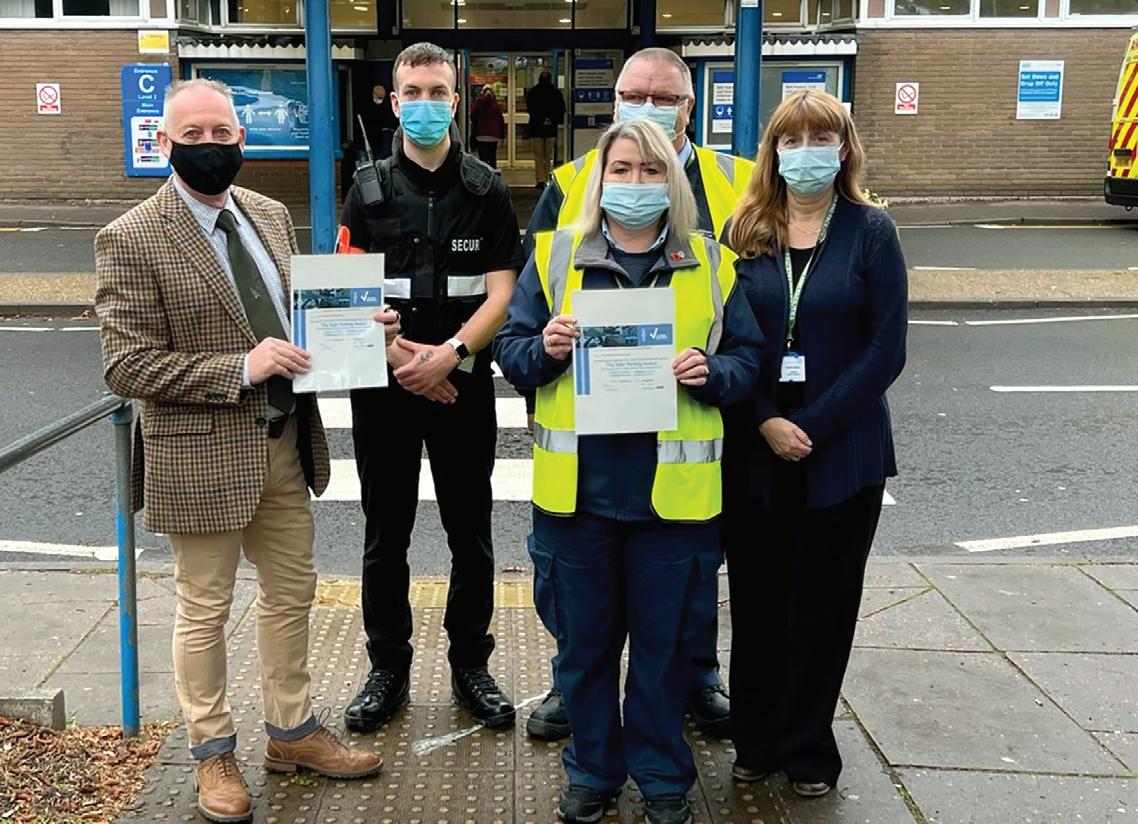
Adam Oxley, trust security and parking manager said: “We recognise the importance in providing a safe and secure environment for patients, visitors and staff. Crime prevention is an integral part of our strategy and has helped to build an excellent pro-security culture.”

Warren Bradshaw, BPA area manager, said: “I am delighted that Eastbourne District General Hospital and the Conquest Hospital Hastings have once again achieved the Park Mark award as it demonstrates the hard work and commitment to providing a safe environment for users.”
Phill Edwards, designing out crime officer, Lewes Police with Elliot Field, security guard, Liz Nicholas, parking supervisor, Nigel Spender, parking officer, and Pauline Blythin, security supervisor
for the growing needs of car users.
The Manors car park in Newcastle upon Tyne is a striking example of brutalist architecture. It was the first multi-storey car park built in the city and formed part of the 1963 Central East Motorway Plan.
This structure makes a strong statement about visionary architecture and bold plans. Newcastle’s motorway plan was imagined by the town planner Sir Wilfred Burns, who headed a newly created department in the city that sought to increase economic prosperity by catering
The car park’s unusual curved design creates a sense of motion. Its shape was dictated by the rail line on one side and the new motorway that swept in front and beneath.

To the right is a sweeping elevated walkway that soars over the motorway into the city centre. The walkway is now a thoroughfare for students at the new Northumbria University buildings to the east of the city, uniting the priorities of the past with the needs of a modern city.
The car park still forms a key part of the city’s infrastructure at a time when we are reimagining our relationship with both cars and cities.
It is interesting to note in the picture that the office building is barely lit even
A man stopped by police officers in Nottingham revealed that he had been driving without a licence or insurance for more than 70 years.
Nottinghamshire police officers said they just happened to pull over the man driving a three-door Mini One in a Tesco Extra car park in the market town of Bulwell.

The man, who was born in 1938, admitted he had not had a driving licence or insurance since he was 12 years old, and had avoided being stopped by police ever since.
The force posted an account
on Facebook: “We can’t quite believe what happened next, as the driver, who was born in 1938 (!!), coughed that he had been driving with no licence and no insurance, since he was 12 (yes TWELVE) years old… and somehow had managed to never be stopped by the police. (We’ll let you do the maths!!).
“Thankfully he had never had an accident, caused anyone an injury, and never made anyone lose out financially, by hitting them whilst uninsured!
“Due to the increased number of ANPR camera’s in Nottingham, even on the small
though it is about 6pm in the evening. It suggests our cities will still have some adapting to do post-COVID.
The brutalist style was developed in the UK in the 1950s and showcases the “bare bones” of the structure and the raw materials, typically a pre-dominance of poured concrete. The style fell out of favour in the 1970s and now divides opinion. But as a style that marked the confidence of a nation, brutalism still has a big story to tell.
David Peach is MD of Workflow Dynamics and business development director of The Parking Shop. He is also a creative photographer with an interest in urban landscapes.
www.davidpeachphotography.com Instagram @davidpeachphotography
trips, you are likely to hit a camera, so make sure your documents are in order... because it will catch up with you… one day…”
attracts a punishment of between three and six penalty points, depending on the nature of the offence. It can also warrant an unlimited fine if the driver has no insurance.
as a symbol of 1960s optimism










Established in 1991, with over 230 sa琀s昀ed customers comprising both public and private sector (including Local Authority and Health and Educa琀on establishments). Quality parking solu琀ons provided by our experienced in house specialists:
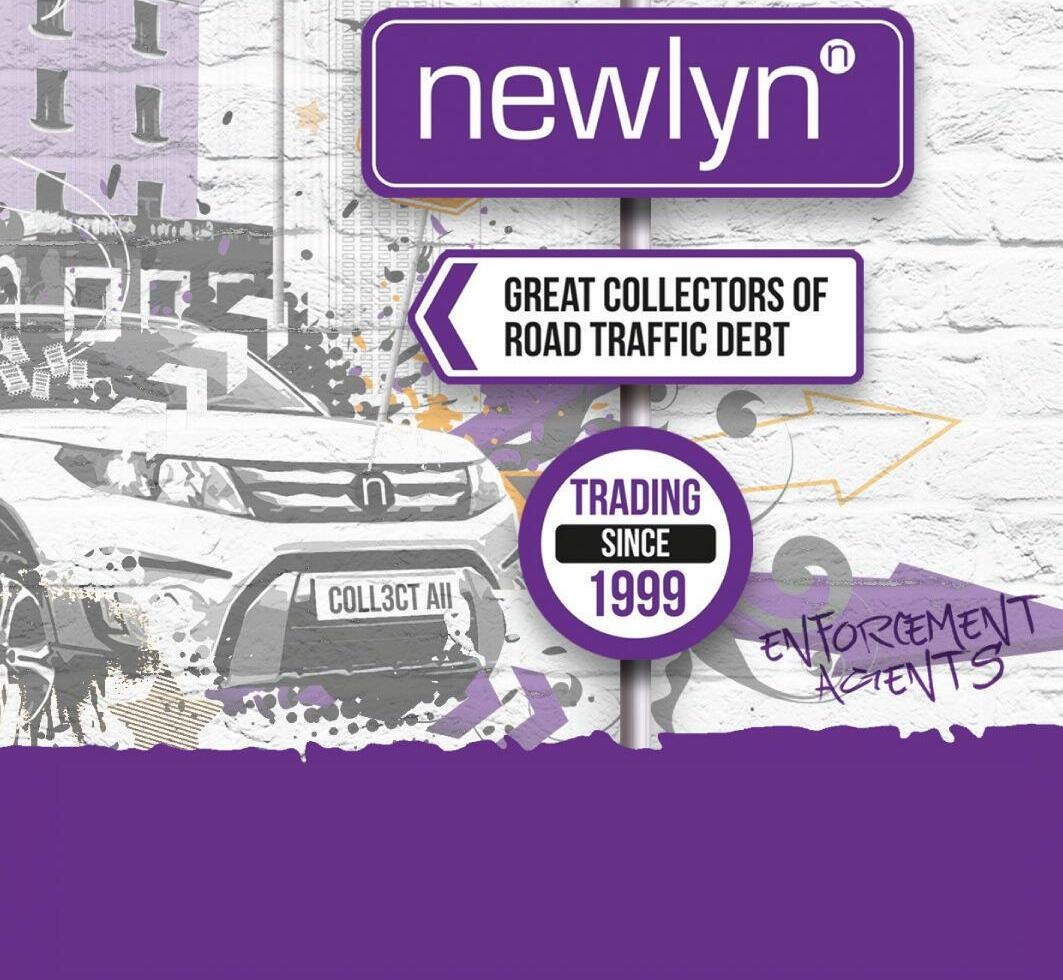
GIS mapping and surveying
• MTO site surveys and digi琀sing.
• On street TRO signs and lines: legality and condi琀on surveys (sample surveys also available).
• GIS mapping of TRO surveys, produc琀on of digital maps and TRO management for Order wri琀ng, upda琀ng and consolida琀on.
• Data extrac琀on and conversion of text based schedules to digi琀sed map based solu琀ons.
• Length of stay, usage, and occupancy parking surveys, both on and o昀 street.

• Compliance surveys and data analysis.
• Surveying and mapping of infrastructure assets.
• Financial appraisal and e�ciency reviews of parking service provision.



• Collabora琀ve working – joint no琀ce processing and shared enforcement.
• On and O昀 street tra�c regula琀on order wri琀ng.
• DPE and CPE feasibility studies and implementa琀on.
• Tari昀 reviews.
• DPE/CPE services speci昀ca琀on wri琀ng and tender evalua琀on.

Contact: Peter Lowe B.Eng., C.Eng., M.I.C.E., FBPA Tel: 01492585055 or 07900264137 Email: plowe@rtaassociates.co.uk
RTA Associates Ltd www.rtaassociates.co.uk
































Work with us to scale-up your EV charging capabilities.

Zest is the new EV charging company created by one of the most experienced teams in the business. Backed by the UK Government’s Charging Infrastructure Investment Fund (CIIF), we can offer 100% funding, including AC chargers.
We take care of everything, from supply and installation to payments and customer support. Whether your priority is improving customer experience, generating new revenues or meeting your net zero objectives, we can help.
Let’s explore how we can work together. Email hello@zest.uk.com or scan the QR code for more information.